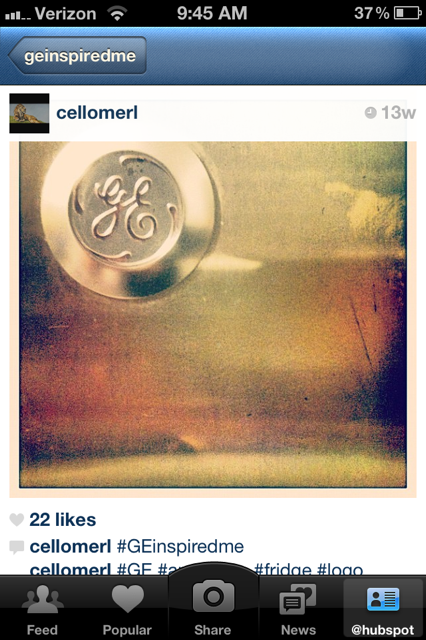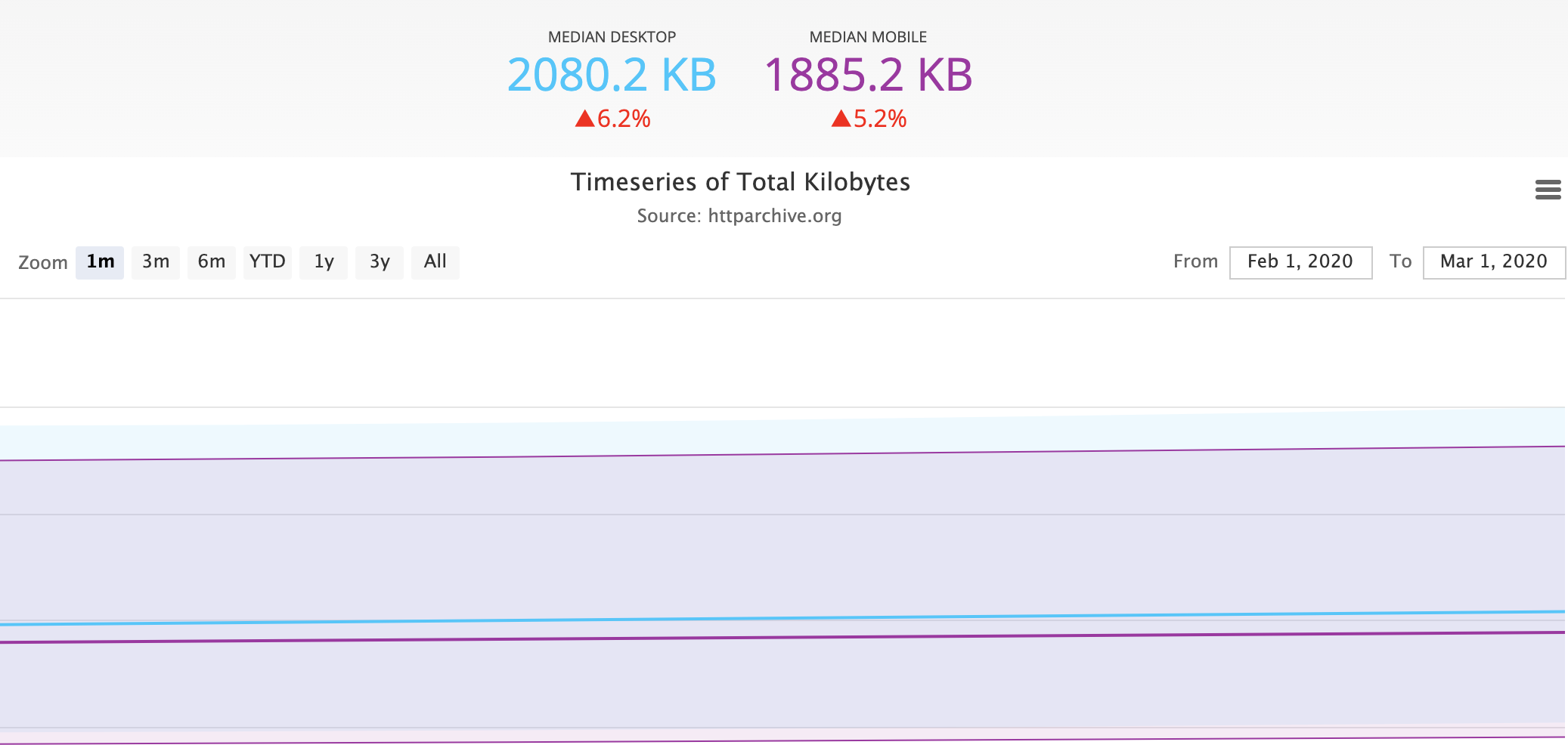Operational Management | Department of Energy
Operations Coach and Operations Management
What Can I Do With a Operations Management Major? | Eller College of Management | The University of Arizona
What Is Inventory Management Process? (& How To Implement It)
The post What Is Inventory Management Process? (& How To Implement It) appeared first on Tallyfy.
Inventory management is at the core of each business’ trading activity, a key component of supply chain management. It is a vital process of monitoring, managing, and controlling the stock items of your company. It won’t be an exaggeration if we claim that it is the center of all trading activities within a company – […]
The post What Is Inventory Management Process? (& How To Implement It) appeared first on Tallyfy.
How to Make a Slack Bot using Slack API (8 Simple Steps)
The post How to Make a Slack Bot using Slack API (8 Simple Steps) appeared first on Tallyfy.
Over the last few years, Slack has skyrocketed to become one of the most widely-used business platforms around. The company’s commitment to creating minimalist, yet useful software has won over business people worldwide. Slack has offered a number of ways to get more out of their platform beyond just vanilla Slack. Slack allows for endless […]
The post How to Make a Slack Bot using Slack API (8 Simple Steps) appeared first on Tallyfy.
The Ultimate Employee Offboarding Guide [w/ Process Flow Chart and Checklists]
The post The Ultimate Employee Offboarding Guide [w/ Process Flow Chart and Checklists] appeared first on Tallyfy.
You spend many many hours, energy, and money trying to find the right person to hire. And then you also spend a ton of resources on that employee’s onboarding. When it comes employee offboarding however, you don’t really worry as much. The employee offboarding process isn’t just about leaving your outgoing employee feeling good – […]
The post The Ultimate Employee Offboarding Guide [w/ Process Flow Chart and Checklists] appeared first on Tallyfy.
What is Lean Management & How To Make Processes Leaner
The post What is Lean Management & How To Make Processes Leaner appeared first on Tallyfy.
In the contemporary business world, more and more companies are entering the market and striving for the same target group. As a result, competition grows more vicious with each passing day and businesses ought to find ways to reduce customer churn and to gain a competitive advantage over others. One way to gain such is […]
The post What is Lean Management & How To Make Processes Leaner appeared first on Tallyfy.
PaynPark uses Tallyfy to optimize their customer experience
The post PaynPark uses Tallyfy to optimize their customer experience appeared first on Tallyfy.
What was happening in your business that caused you to start using Tallyfy? PaynPark is an independent parking system focused on optimizing positive customer experience. In order to make our customers processes as quick and as easy as possible, we must simplify our own first. As a team, PaynPark required a system with steps viewable […]
The post PaynPark uses Tallyfy to optimize their customer experience appeared first on Tallyfy.
A Complete Guide to Calculating MRR/ARR for Your Business
The post A Complete Guide to Calculating MRR/ARR for Your Business appeared first on Tallyfy.
Let me guess, you’re either starting a company or you’re looking to scale your SaaS for your already existing business and you’re not really sure where to start. I feel you. It’s a bit scary at first having to deal with finance, but don’t worry, it’s simpler than it looks. In this quite comprehensive guide, […]
The post A Complete Guide to Calculating MRR/ARR for Your Business appeared first on Tallyfy.
Step by Step Guide to Agile Project Management
The post Step by Step Guide to Agile Project Management appeared first on Tallyfy.
Agile project management is a project planning and business process management approach that involves iteration. It is heavily concentrated on improving continuously and increasing the value of the project. In agile project management, the main target or goal is to improve the project, which is the developmental process of a product or a service. This […]
The post Step by Step Guide to Agile Project Management appeared first on Tallyfy.
McKinsey’s 7S Framework – What, How and Why?
The post McKinsey’s 7S Framework – What, How and Why? appeared first on Tallyfy.
An organization as a whole can be re-imagined as a living being, with its departments acting as the organs. Likewise, when applying Darwin’s ‘Survival of the fittest’ principle, it is evident how companies strive to be the best, or else they will soon meet bankruptcy (extinction). One notable example which suits this comparison is how […]
The post McKinsey’s 7S Framework – What, How and Why? appeared first on Tallyfy.
What is a Workflow Model and How to Create One
The post What is a Workflow Model and How to Create One appeared first on Tallyfy.
It is of extreme importance for companies nowadays to strive for process efficiency and added value for customers. Since the barriers to entry are diminishing, there is a rapid growth of firms storming the market gates and clinching their teeth on market share. This is forcing everyone else to spend more time on thinking of […]
The post What is a Workflow Model and How to Create One appeared first on Tallyfy.
Should You Hire an Organizational Effectiveness Consultant?
What are the benefits to hiring an organizational effectiveness consultant? Learn the pros and cons of hiring a consultant in this article.
Why Change Management is Apparel’s Best Response to Trade Uncertainty –
Sourcing Journal’s Optimizing Productivity Report advises on the best ways for apparel and footwear companies to weed out inefficiencies.
Business Operational Management
Implementing Cloud: The need to enforce Change Management Process
The business benefits of Cloud have already been felt by forward-thinking organizations that have long been in the game.Especially in the financial sector,…
Leading Process Improvement – Project Initiation – Change Management World
One key challenge in Process Improvement Leadership can be the initiation of projects. As a CPI Leader you may or may not be privy to the challenges occurring in other departments (or, on a larger scale, other facilities). In a large (multi-site) organization it makes sense to coordinate…
Why Change Management
There is a common denominator for achieving the intended outcomes of your initiative: people. Your initiatives impact how individual people do their work: their processes, job roles, workflows, reporting structures, behaviors and even their identity within the organization.
The Value of Configuration Management
For the purpose of understanding the value of Configuration Management, we have to trace how value is added to transactions. The value transaction is important to the supplier because that is where value the customer is measured.
The Pros and Cons of Organizational Culture Transformation
In this article, we’ll look at the pros and cons of organizational culture transformation, when to transform, and a few best practices for changing culture.
Five steps toward ethical AI adoption
Todd Lohr says businesses should prepare for structural changes and ethical workplace transformation by helping employees adjust to the role of machines in their jobs….
Misconceptions About COO Duties And How A Fractional COO Can Maximize Your Operations | Kamyar Shah
Starting With Your New Remote Chief Operating Officer So you have decided to hire an interim or part-time Chief Operations Officer. What are the next steps for
Chief Operating Officer’s insight:
Misconceptions About CMO Duties And How A Fractional CMO Can Help Maximize Results | Kamyar Shah
Laying The Foundation For Your New CMO So you have decided to hire an interim or part-time CMO. What are the next steps for your business and how will your
Chief Operating Officer’s insight:
What are SAFE and Crowd SAFE notes?
The post What are SAFE and Crowd SAFE notes? appeared first on Tallyfy.
What is a SAFE note? A story about dreams, dollars and … funding! Marisa and Kyle were both business majors at University of Iowa when they conceived of their small business idea: an app which provided ratings for various meetups at their college. They later realized the idea could apply to meetups everywhere as well! […]
The post What are SAFE and Crowd SAFE notes? appeared first on Tallyfy.
Patent - Term of the Day - Mar 20, 2020
Inflation - Term of the Day - Mar 23, 2020
Inventory Adjustments - Term of the Day - Mar 24, 2020
Liability - Term of the Day - Mar 25, 2020
Sector - Term of the Day - Mar 26, 2020
Deduction - Term of the Day - Mar 27, 2020
Lien - Term of the Day - Mar 31, 2020
The Plain-English Guide to Local PPC
For the last few weeks, my husband and I have been ordering more takeout than ever.
As we were trying to find a restaurant to order from, we came across an online ad for one of our favorite local restaurants that just started offering delivery.
We were so excited and immediately placed an order.
That's why local pay-per-click (PPC) can be a great option for local businesses.
Even when budgets are tight, a local PPC campaign can improve the efficiency of your local marketing as it allows you to get in front of the right audience.
Below, let's review the benefits and top strategies for implementing a successful PPC campaign.
Benefits of Local PPC
When you own or run a local business, you know it can be hard to get in front of the right audience. When the budget is tight, it can be even harder.
However, with local PPC campaigns, you can run effective online advertising without breaking the bank.
Below, let's discuss the top benefits of local PPC.
1. Running relevant ads.
With local PPC, your ads will only show up in front of the right audiences because you're in control of who you're targeting. Ideally, you're only targeting people who can benefit from your business.
Additionally, you won't be competing with national big names, so your budget will go a lot further. With more local campaigns, you'll see less competition and more clicks and conversions.
2. Increasing brand awareness.
As a local business, it's always important to get your name out there so your local community knows you exist.
With a local PPC campaign, you'll increase brand awareness just by getting your name out there and in front of your audience. Even if those people don't convert, brand awareness is very important in the success of a local business.
3. Improving conversions.
With people shifting to online shopping, it's more important than ever to run a local PPC campaign.
When local audiences see your ad during their online shopping search, they're more likely to convert because they're actively searching for a solution to their problem.
4. Easily trackable.
Local PPC ads are easier to track than other local marketing tactics like banners or flyers. With these ads, you can see impressions, clicks, and conversions.
5. Low barrier to entry.
If you're new to online advertising, local PPC is a great place to start. You don't need to have a ton of SEO knowledge to run a local PPC campaign.
With local PPC, you can easily target people outside of your existing followers and cast a wide net to find new customers. Plus, most of the steps are intuitive when you're in a PPC platform.
6. Flexible options.
With local PPC, there's a lot of flexibility. For instance, you don't have to spend a lot of money to see success. You can choose your budget and set a limit on what you're willing to spend.
Then, if things go well, you can immediately scale up. On the other hand, you can also pause campaigns whenever you need to.
Additionally, local PPC ads give you flexibility with your targeting options. You can run ads based on geographic location or specific behaviors.
Local PPC Strategy
Now that we know what local PPC is and the benefits of running a local PPC campaign, let's review the top strategies to get started.
1. Be specific with location.
When you're deciding what locations to target, be specific. For instance, you can use zipcodes or city names to describe your service area.
However, keep in mind that it's just as important to exclude areas where potential customers aren't.
When you're more specific with location, you'll use your budget wisely so your ad never shows up to someone who can't use your service.
2. Use the local language in your keywords.
The language in your PPC ads should be specific to your location. For instance, you can use Google Trends to see if people in your area are more likely to search "tennis shoes" than "sneakers."
Additionally, you should include the location in your ad. For example, including the city name in your title can remove unqualified traffic from clicking on your ad. This will also save you money, so you don't have to pay for a click that'll never convert.
Using hyper-local language will help you succeed in local PPC.
3. Quickly test and optimize.
With local PPC campaigns, you can quickly test and optimize your ads based on immediate results.
A part of your local PPC strategy should be to make changes quickly when you see an ad performing well or underperforming.
Additionally, you can implement A/B testing to help you decide what ad will be more successful in your area.
4. Analyze the results of your current SEO.
If you track the health of your SEO, you should take note of your best-performing keywords and target those in your local PPC campaign.
For instance, if you see that a keyword performs well in organic rankings, you should use that keyword in your paid campaigns as well.
Typically, you can find these keywords in tools like Google Search Console, SEMrush or Ahrefs.
5. Enable ad extensions.
With ad extensions, you can include more details in your local PPC campaign. The more details you add, the better your ads will perform and the more you'll get out of your budget.
You can add extensions such as location or call extensions. With these extensions, you can add more business information including your address and phone number. Additionally, call extensions can add a clickable button so customers can call you directly.
Before you enable ad extensions, make sure your Google My Business account information is up to date. Local PPC platforms pull data from GMB.
6. Use multiple PPC platforms.
You can run a local PPC ad on social media platforms or search engines. To reach more people with your online advertising, try using several platforms.
Additionally, you might be able to use your marketing automation software to facilitate the process. For example, with HubSpot Marketing Hub, you can use the Ads Management tool to track and manage your PPC ads.
7. Don't neglect your landing page.
The website or landing page your PPC ad directs visitors to is very important. For instance, your site should include contact information that is easy to find so there's no friction in the conversion process.
Additionally, your copy and images should highlight community love, either with local awards, local images, or local keywords.
Implementing a local PPC strategy doesn't have to break the bank. Even more, it can be a cost-effective way to reach local audiences and increase brand awareness.

How to Run a Social Media Contest That Gets Tons of Engagement (11 Contest Ideas)
There are so many rules and guidelines and so much planning and preparation involved. A contest could be the best tactic you’ve ever introduced to grow your reach, drive site traffic, and generate leads, but you want to ensure you're doing it right.
Here's how you can set yourself up for success with contests on Facebook, Twitter, Pinterest, and Instagram.
How to Run a Contest on Facebook
Facebook is the most widely used social media platform, so running a contest on Facebook makes sense. After all, your prospects most likely hang out here. Here are some best practices:
Follow the Rules
Before you start your Facebook contest, make sure you can actually run it legally. Facebook has cracked down on contests due to liability issues, so read through their strict rules ahead of time. Some of those rules include:
- The onus is on you to communicate the terms of the contest.
- You must acknowledge that Facebook has not sponsored the contest and is not liable in its administration.
- You cannot use personal timelines as an entry mechanism for the contest (e.g. sharing, tagging, etc.).
In general, you can assume you're responsible for the legal and logistical portions of your contest; Facebook just provides the people.
To learn more about Facebook’s contest rules, visit their Page Guidelines.
Include a Form on a Landing Page to Generate Leads
If your goal is to generate leads from your contest, you might want to include a form directly on your landing page. This will make the process much easier for people trying to register for the contest. Avoid making your entrants dig through mountains of rules or a maze of links to get to where they want to go.
Create Your Own Terms & Conditions / Official Rules Page
Facebook makes it very clear that you must provide the official terms, rules, and eligibility requirements for your contest. You need to “include a complete release of Facebook by each entrant or participant and include acknowledgement that the promotion is in no way sponsored, endorsed, or administered by, or associated with, Facebook.” In addition, it is important to provide disclosure information — that if the participant is filling out a form and giving you personal information, that information is going to you and not to Facebook.
Make Use of Third Party Apps
The most common and effective way of managing Facebook contests is by using third party apps — some good ones are ShortStack, Woobox, and Offerpop. All of these make it easier to track participation and measure engagement.
Give Away Something Awesome
If you’re asking people to fill out a form, tell a story about their first experience with your brand, or explain why they love your product, a lousy keychain will not incentivize many entrants. If you have an amazing prize, people are more likely to put some serious effort into your contest.
Remember Your Goals and Measure Your Results
You can create the most impressive contest in the world, but if it doesn't align with your goals or if you didn’t measure it correctly, who really cares? If you want to generate leads from your contest, for example, you know you need to collect entrants’ information via a form. If you're looking to build reach and brand awareness, have entrants engage with the contest in some way. Whatever the objective is, Facebook Insights can let you know how much your reach has grown, or you can invest in closed-loop marketing software to track the number of leads generated and the growth of your reach.
How to Run a Contest on Twitter
Nearly 330 million people are active on Twitter, and 40% of Twitter users purchased something after seeing it on the platform. This makes it a great platform to spread brand awareness through a contest.
Follow the Rules
When you’re running a contest, just like any day on Twitter, make sure you’re following Twitter's rules. Discourage dishonest behavior such as the creation of multiple accounts or posting the same tweet repeatedly. However, do encourage good behavior such as topic relevance and creativity. Your entrants must also comply with applicable laws and regulations — Twitter makes it clear that this portion is your responsibility. In other words, you write the official rules, and any legal backlash will be your problem, not Twitter’s.
Set Your Goals
If you don't know what you’re looking to achieve with the contest, how will you know if you’ve achieved it? Plus, your goals will help you figure out how to run the contest. If you’re looking to promote a specific event or offer, for example, have your entrants tweet a link to it; just make sure you’re using tracking tokens to measure your leads and clicks to see exactly how successful the contest was. If you are trying to improve reach, on the other hand, have entrants retweet the original tweet you sent out about the contest. And if you’re looking to build awareness of your brand, require your entrants to follow you in order to be eligible.
Hey Word Nerds! RT to win a $50 Game Card! One winner a week, winner chosen on Fridays, contest ends 7/1 #ZyngaLove50
— Words With Friends (@WordsWFriends) June 26, 2012
Iron Out the Details, Including Contest Type and Timing
There are several types of contests you could choose from, so make sure you pick one that aligns with your goals. Popular types of contests on Twitter include:
- Sweepstakes-style contests - Great for generating leads if you have them sign up on your site or reach if you require a follow and retweet for entry.
- Caption or creative answer contests - Great for improving engagement.
- Photo contests - Great for spreading awareness for your contest if you require them to post the photo to their own Twitter feed.
You also need to figure out when the contest will take place, how long it will run, and when the announcement of the contest will take place — will it be days before via your blog and other social media networks, or just minutes before the contest? Once you have your goals set, details like these are the easy part.
Direct Users to Mention You or Create a Specific Hashtag for the Contest
It’s impossible to honestly select a winner for a contest if you can’t find and weed through all the submissions. Make sure you set yourself up for success by creating streams specifically dedicated to the contest.
When tweeting the announcement that you’re having a contest, ask users to include either an @mention to you in their tweet or a specific hashtag dedicated to the contest or campaign you’re running at the time. This way you can clearly see all the entrants, making your life much easier when the time comes to select a winner.
Measure Your Results
Track your contest hashtag over time using a third-party app, use a contest-specific bit.ly link, or view any contest-generated traffic using an analytics platform or your marketing software.
How to Run a Contest on Pinterest
Pinterest has more than 322 million monthly active users, and about 70% of them are female. If your target audience is women, and you're in a creative or visual industry, Pinterest is a great choice for your contest. Here are some tips to knock it out of the park:
Follow Proper Pin Etiquette
Pinterest has relaxed guidelines for running contests:
- Don’t suggest that your contest is endorsed by Pinterest.
- Don’t require users to save a specific image.
- Don’t allow more than one entry per person.
- Follow the Pinterest brand guidelines and terms of service.
In a nutshell, Pinterest encourages users to be respectful and authentic. For a more in-depth understanding of their rules, access their Community Guidelines.
This contest from Garnet Hill falls right in line with what pinners love to do.
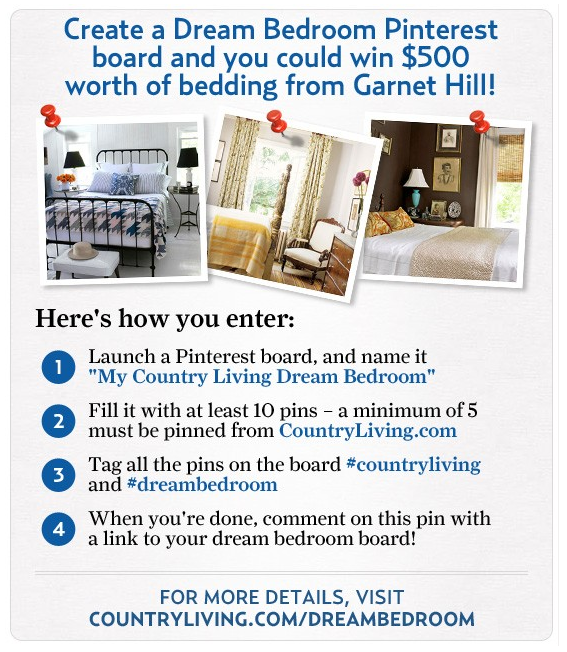
Make an Announcement
Leverage your social networks. Don’t just announce that you’re having a contest on Pinterest; tell your followers on Twitter, your fans on Facebook, and your following on Instagram, too. Depending on the length of the contest, you should make social promotion a regular part of your social media schedule to encourage participation.
Clearly Articulate the Rules of the Contest
Whether you’re asking entrants to create a whole new board for your contest, like Garnet Hill, or you want them to simply repin one image, let participants know so they can follow your rules properly. Include a bullet point list of the rules right on a repinnable image. Behind the image, include a link to more details about your contest using a landing page on your website.
Remember Your Goals and Measure Your Results
Tailor your contest to suit your goals and measure your results accordingly. For example, if you are looking to generate leads and you could care less about engagement, you wouldn’t measure reach. If you align your goals and metrics with your contest, you'll be much more successful in the long-run.
Use a Pre-Defined Hashtag to Find Submissions
Use a hashtag so people can follow the contest entries on Pinterest. This will help spread the word about your contest, and it can also help you find participants. If you’re requiring entrants to create a board for your contest, have them use a pre-defined hashtag on their images so it's easy to find. Or are they simply repinning the original contest image? That’s easy -- just click on the pin to see who repinned it!
Have a Prize Your Audience Will Love
If participants are creating an entire board on their Pinterest account dedicated to your company, you’ll need to give away something really awesome. The more effort your participants need to put in, the better the prize should be. You will get fewer participants with a contest giving away a koozie than a contest giving away an entire bedroom set. Plus, a prize like a beautiful new bedroom set plays right into the interests of Pinterest users — beautiful, visual items.
How to Run a Contest on Instagram
Like Pinterest, Instagram is a visual social media platform. If you have aesthetic products or are creating a striking campaign, it will do well on this platform. Here are some tips to get the most out of your Instagram contest:
Follow Best Practices
Instagram, now owned by Facebook but independently managed, has similar rules for running contests. The big one being that Instagram does not want any language that implies endorsement, and they do not want to be involved in the administration of the contest. You can read more about Instagram’s contest rules here.
Set Your Goals and Clearly Articulate the Rules
Your goals should be directly correlated with how you run your contest. If you want to drive traffic to your website, make participants go there to enter. If you’re more interested in boosting engagement, have them leave a comment. You are the owner of your contest, so only you get to decide what is required for entry.

Make an Announcement
Photos on Instagram fly through the feed so quickly, you might have trouble being successful with only one contest announcement. Promote the contest on your website and other social networks to get as many participants as possible. You can certainly post about the contest multiple times if you keep it creative and always craft unique updates.
Follow a Theme to Inspire Excitement in Your Followers
Are you currently running a campaign that you want your contest to run alongside of? Follow the same theme. Your Instagram followers are certainly a creative bunch, so even if you’re a B2B company, they will find a way to add excitement to your brand. For example, GE ran a contest on Instagram using the hashtag #geinspiredme. After the contest, they featured the top photos as a board on their Pinterest account.
![GE Inspired Instagram Contest]()
Consider a Hashtag or RSS Feed to Filter Submissions
Using a hashtag, like GE did, is a great way to filter your contest. However, if you get thousands of submissions, it might be tough to weed through them all. So in addition to the hashtag, try filtering with an RSS feed. Webstagram allows you to search a hashtag, and you can view every Instagram photo using this tag with the original caption and comments.
Measure Your Results
Statigram is a great site for management, measurement, and promotion on Instagram. And lucky for you, it even has a "Contest" section with a toolkit for running photo contests. Now that you have all the tools working for you, match your measurement tactics with your goals and rules, and your contest should be a breeze.
Social Media Contest Ideas (With Examples)
Once you have determined what channel(s) to run your contest on, the fun part begins: outlining the details and rules for entry. Below are some contest ideas to help you get your creative juices flowing:
1. Ask them to tag a friend or share to win.

This is one of the most common types of social media contest because it necessitates entrants to spread the word, which in turn attracts other entrants.
209 Magazine used Instagram to promote their contest so they could take advantage of hashtags. Notice that they used local hashtags, which means that they'll likely get participants in their local area, making for a more targeted approach to the contest. The end result being new local followers who may be interested in additional content from the magazine.
2. Ask them to showcase their creativity.
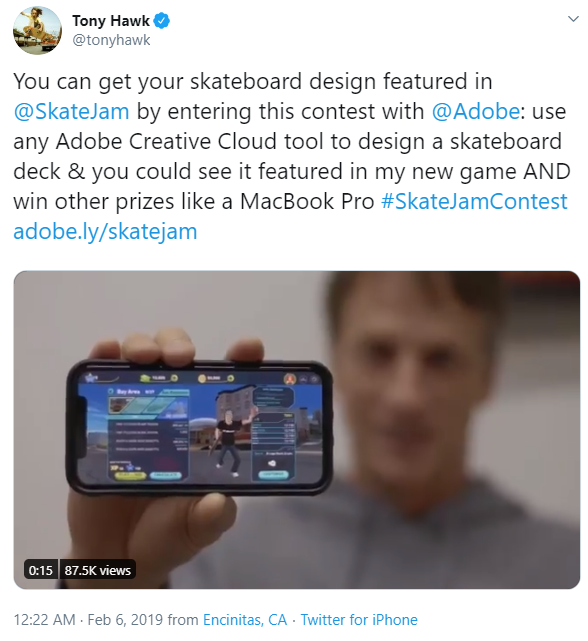
Many people are inherently creative, but unless they work in a creative field, they may not have the opportunity to indulge in artistic endeavors as often as they'd like. This is why coloring, poetry, and art contests are a great choice for social media — participants are incentivized by both the prize and the means to get it.
This Twitter contest by Tony Hawk, SkateJam, and Adobe is an excellent example for a few reasons:
- It's a partnership between multiple brands who can cross-promote.
- The rules of the contest require using one of the brand's products to enter.
- Not only are entrants eligible for a cool prize, but they also could see their art featured in the game! How cool is that?
3. Ask them to get on camera.

Photo contests are a great option because many people access social media platforms on mobile devices. That means the camera is likely built into the device they're using when they first see the contest announcement, making for a frictionless entry. Plus, it can be fun to be a model for a day.
Torrid, a plus-size clothing brand, is on a mission to make their customers feel confident and beautiful when wearing their products. With this in mind, photo contests like this one they held on Facebook are greatly aligned with their overall brand.
4. Ask them to share their opinion.
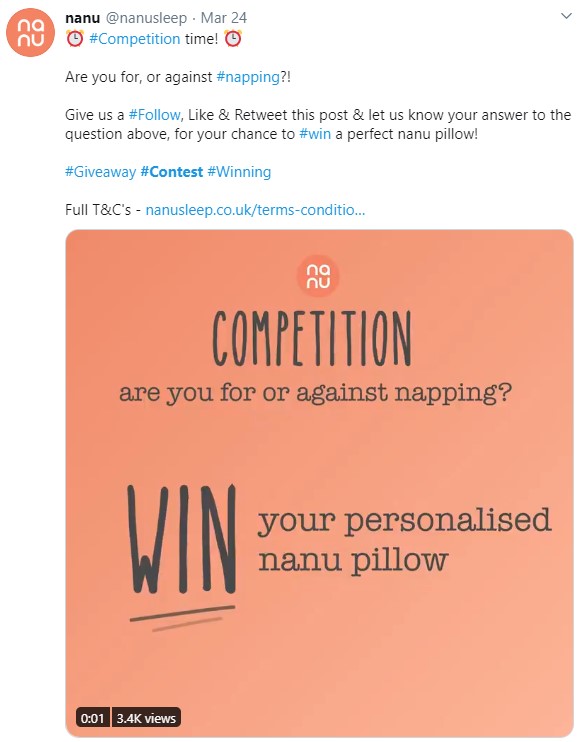
If you've ever read the comments section of a trending social media post, you know that people are social and love to share their opinions. Consider prompting participants with a question they must answer in order to enter the contest. By asking them to share their opinion, you're getting them to think about a topic related to your brand, and you benefit from the engagement and interaction that happens as a result.
Nanu, a company that offers personalized pillows, decided to ask Twitter users about their napping habits for the chance to win free product. This spreads awareness about their product while staying on topic, bringing their offerings top of mind.
5. Ask them to contribute and be featured.
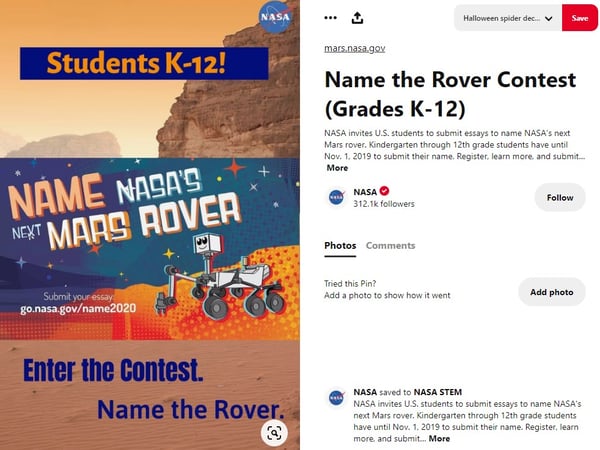
Recognition is a common motivator, so contests where being featured is the prize can have pretty decent success. These types of contests are a great idea because:
- You get free content in the form of contributions.
- The prize is promoting the best contribution.
- You get amazing brand awareness as entrants must think about how they want to contribute.
In some cases, just being featured might be a good enough accolade to motivate people to enter. In others, you may want to consider an additional prize similar to the way the Tony Hawk example does.
This NASA example on Pinterest is particularly neat because it targets K-12 students as entrants, spreading interest for the STEM field. The prize is pretty cool, too: The winner gets to brag that they contributed to a space project.
6. Ask them for laughs.

They say that laughing takes years off our lives, and incorporating it into social media can bring some of that energy into your marketing. One of the best ways to incorporate humor into a social media contest is with caption contests. Post a photo with no context, ask participants to caption the photo to enter the contest, and then crown the funniest submission as the winner.
The BYU Alumni department held one of these contests on Twitter. It works particularly well not only for the humor factor but also in that it serves to remind alumni of crazy college antics. The more that BYU is able to tap into this nostalgia factor, the better their relationships with the alumni get.
7. Ask them to vote.
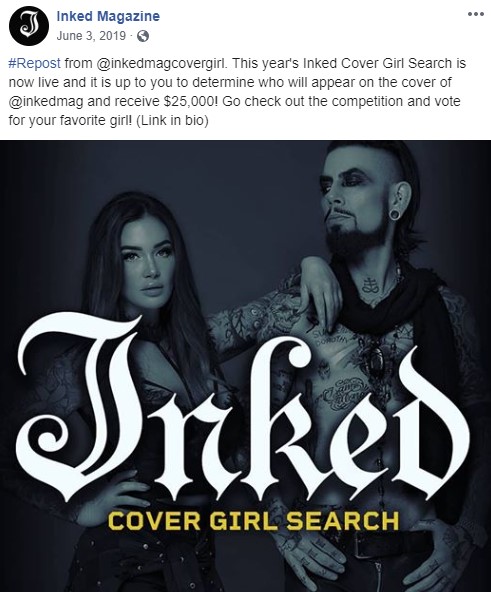
Contests that have a voting element are great for engagement because it prompts users to interact in order to win, and it's in the contestants' best interests to spread the word.
This Facebook contest by Inked Magazine is a great example of this. The winner gets featured on the cover of this prominent publication in addition to some pretty serious monetary winnings. Inked Magazine asks for followers to participate by voting, and the final contestants will also likely be asking their circle of influence to participate. This drives awareness of Inked Magazine's brand.
8. Ask them what they know.
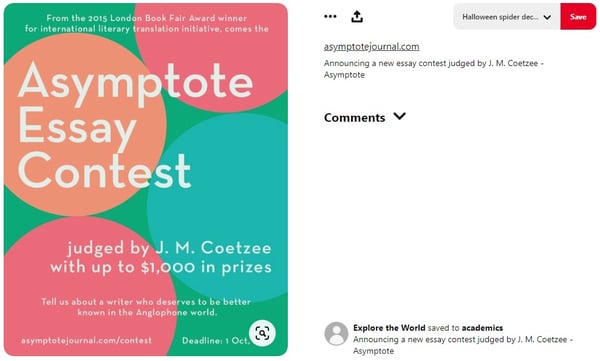
One of the coolest things about social media is how quickly information can be shared. One contest idea is to tap into this by prompting people to demonstrate their knowledge. This can be done by asking them to answer a trivia question, solve a puzzle, or pen an article.
Asymptote Journal taps into this category by promoting their essay contest on Pinterest. Entrants get the chance to win prizes by spreading awareness about an author they want others to know about.
9. Ask them to share a part of their lives with you.
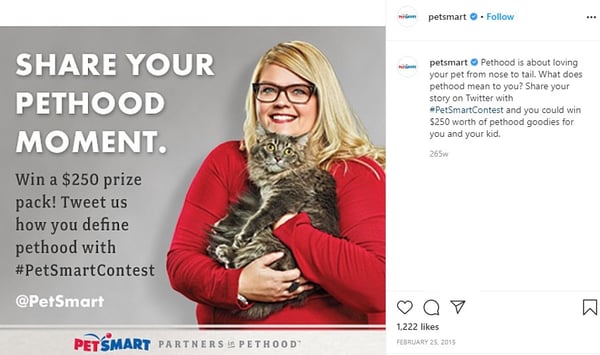
Brands that have the most success on social media are the ones that build a community. That begins with humanizing the brand and also demonstrating compassion for its followers. What better way to do that than not making your social posts about you? Instead, fashion a contest that makes it about the individuals in your community. Ask them questions. Prompt them to talk about things that matter to them. Create discussions.
If there's something that people love to talk about, it's their furbabies. For many of us, pets are a big part of our life, and PetSmart taps into this by asking Instagram followers to share that passion. In addition, this type of contest is on topic for their brand, which keeps people aware of PetSmart and what they offer.
10. Ask them to demonstrate your product.

One of the best ways to engage people with your products is by incentivizing them to do it with a contest. By requesting customer product photos, you benefit from free product placement and social proof, demonstrating that real people use and benefit from them.
Converse is a brand that runs a lot of contests, and they do it magnificently. This example is one they ran on Facebook, and there are a few reasons why it works:
- They've partnered with another brand to benefit from cross-promotion.
- They are targeting existing customers (those who already have Converse shoes) in an effort to engage and delight them.
- Converses have always been an extremely photogenic shoe with mass appeal, and they are emphasizing this appeal to spread brand awareness.
11. Ask them to participate in a challenge.
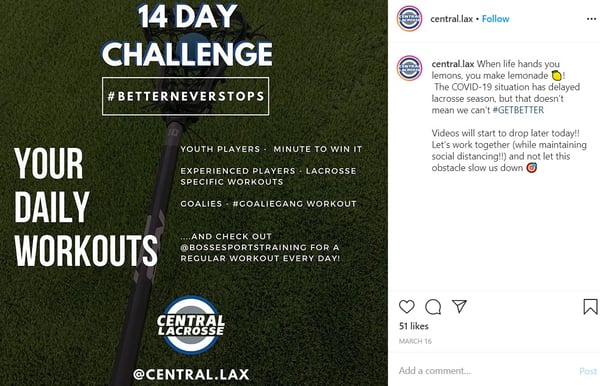
Have you ever been determined to do something because you were dared to? Maybe you became even more adamant about doing it because someone told you that you couldn't. This sentiment is one reason why challenge contests are so popular. Entrants are motivated both by the dare and the vision of victory.
This Instagram contest by Central Lacrosse is interesting because they run the contest over 14 days. That gets people engaged with the challenge over a longer period of time, which extends the effectiveness of the contest's goals. The longer it sticks around, the more people are likely to participate.
Now that you’ve been inspired by all of these ideas, here’s our challenge to you: come up with a great contest that reflects your brand, choose a social channel, come up with an amazing prize, and start earning those sweet, sweet engagement numbers.

Dividend - Term of the Day - Apr 01, 2020
4 Predictions Marketing Experts Got Wrong About Social Media in 2020
As a marketer, reading trending predictions or industry forecasts is the norm.
But sometimes you just want to pull a Regina George and say, "Stop trying to make fetch happen. It's not going to happen."
We've all been there, especially with social media predictions.
Although we're always trying to forecast what the future holds so we can run successful campaigns and strategize for the future, things don't always go as planned.
Sometimes we even get it wrong.
In this post, we're going to look at the top social media predictions that marketing experts got wrong.
Bad Social Media Predictions
1. Google would have a successful social media platform.
Google has been trying to get into the social media game for years. In fact, the company started Google Wave in 2009, Google Buzz in 2010, and Google+ in 2011.
But one after the other, the projects were discontinued or defunct.
However, not everyone saw the writing on the wall. In fact, industry experts were optimistic about Google+.
Although I was never convinced as a user (call me a late adopter), when new social media platforms come around, especially by industry giants like Google, marketers pay attention.
Even when the Google+ founding father left Google, marketers at Marketing Land thought the social network still had a chance.

In 2014, Mark Traphagen predicted that "Google+ the social network and user data infrastructure of Google is not going away" and "the Google+ project has been an incredible success because it drove the unification of Google products."
As it turns out, Google+ happened to follow in its predecessor's footsteps and is officially defunct.
#ScaryStoriesIn5Words People still use Google Plus. 😂✌️ pic.twitter.com/bpdl2BOU1Q
— Larry Kim (@larrykim) October 28, 2016
“Google Plus? More like Google Minus! Am I right people?”
— Seth Masket (@smotus) October 16, 2019
-Me if I were in the #demdebate
2. Facebook use will decline after continued drama.
Is it me or is there always Facebook drama nowadays?
With the Cambridge Analytica scandal, the trending hashtag #DeleteFacebook, and the election scandal, Facebook's reputation has continued to decline.
In fact, some marketers thought the social network would see a decline in users due to the drama.

But, if you were one of the people that thought Facebook would see its end, it turns out you were wrong … so far.
According to HubSpot research, 60% of survey respondents said they haven't left Facebook despite the drama and don't plan to leave.
Even after the Analytica scandal, Facebook still saw a 1.6% increase in active users.
It appears that Facebook users are too invested to cut the chord completely. Facebook has stored memories and connects people to old friends and family.
Additionally, many other accounts of yours might be linked to your Facebook account. Deleting this social network might just be an unnecessary pain.
3. Virtual reality will grow like crazy.
Virtual and augmented reality have been the buzz topic on social media for years now. It seems like I'm always reading about how it's going to grow like crazy.
In 2015, Business Insider said virtual reality would grow like crazy in the next five years. They predicted that "26.5 million units would be sold in 2020."

Additionally, in 2016, Fortune predicted that VR would sell 200 million headsets worldwide by 2020.
Spoiler alert: it hasn't happened.
According to the latest estimated figures, only 7 million VR headsets were sold in 2019 and 14 million are expected to sell for 2020.
With VR, it appears that slow and steady wins the race. Maybe the industry will get there one day.
4. Anonymous social media will get bigger.
Do you remember the social media platforms Secret, YikYak, and Whisper?
Truthfully, me neither. They're all anonymous social media sites, two of which are now defunct. Back in my day, the anonymous social media site du jour was Formspring.
But in 2015 Ryan Holmes, CEO at Hootsuite, predicted that "demand for anonymous social media will only get bigger."
As it turns out, the struggles seemed to continue. There were constant issues of cyberbullying and harassment.
The apps closed down one after another. Secret dissolved in 2015 and YikYak shut down in 2017.
And it looks like Whisper is on the same trajectory. In 2017 the app had to lay off 20% of its employees to save the company. Now, they're having privacy issues. According to "The Washington Post", private data was publicly available.
Plus, the app continues to fall in popularity, landing at 122nd in social networking in the iPhone app store.
Although it can be hard to admit, marketers don't always get it right. And that's okay. All we can do is use the data available to forecast industry trends so we can plan for the future.

25 Stats That Prove Why Workplaces Need to Embrace Diversity
As a legally blind person who's held roles that involve editing, design, and highly visual tasks, I thought I had it easier than a lot of other visually impaired people in my field.
I'd never been blatantly discriminated against or felt like I didn't receive an offer due to my vision. In fact, I've been lucky enough to work on teams run by women or diverse leaders.
However, as I got older, I realized that I hadn't completely evaded misjudgments related to my eyesight. While I've had a handful of great experiences, I've run into a few subtle job interview scenarios that seem more and more unacceptable each time I reflect on them.
In my first job search after college, I realized that disclosing my blindness would always result in a look of concern or an incredibly awkward series of questions from a hiring manager. Many of these questions didn't even have to do with the job role I was interviewing for.
Sometimes, an interviewer would try to hide a look of concern. Then, they'd make things even more awkward by trying to relate to me with statements like, "My second cousin is blind too! I should ask her what she has."
Ultimately, I followed my instincts and didn't work for any of these people. However, even after I built a list of glowing recommendations from past employers, those uncomfortable interview memories stuck with me.
Because of how these experiences, I felt like I had to give certain prospective companies a "fluffier" description of my sight to protect myself against any possibility of job discrimination.
For example, if a hiring manager noticed my low vision, I'd say, "I'm just visually impaired" or "I'm super nearsighted." If I didn't think they could tell, I'd say nothing about it until I was handed an offer. Even when filling out anonymous self-identification forms on job applications, I'd always decline to check the "disabled" box.
It wasn't until I learned more about self-advocacy and workplace inclusion that I realized that some of the interview experiences I had weren't okay. And, by following my gut instinct of not working for employers that made me feel uncomfortable during the interview process, I ended up working for employers that accepted and empowered me.
Today, I work at HubSpot, a company that heavily invests heavily in diversity and inclusion. Because my organization is always taking steps to make everyone feel a sense of belonging, I find it much easier to open up about my own differences.
But, as I've learned, most companies aren't as forward-thinking as HubSpot. And the sad reality is, people like me still do feel that they need to protect themselves from job discrimination.
Although my negative workplace experiences have been light, I personally know plenty of people who've dealt with something worse due to a disability, cultural background, or gender identity.
In fact, three in five people have experienced or witnessed workplace discrimination.
Scary right?
This is why businesses need to invest in diversity and inclusion.
Diversity and inclusion isn't just a strategy that helps managers keep employees feeling psychologically safe. Embracing diverse backgrounds also opens the door to better problem solving and innovative ideas.
In fact, diversity is so important to innovation that HubSpot's CTO Dharmesh Shah took the main stage at INBOUND 2019 to make the case for it.
In his speech, Shah told the story of YouTube's early days. When the platform first launched its app, they realized that 10% of users were uploading horizontal videos upside-down.
Upon further research, YouTube's team realized that 10% of the population was left-handed. When these left-handed users filmed videos from their own perspective, they held the phone in the opposite way that the average right-handed users would. As it turns out, there were no left-handed people on the app's early team to point out this UX issue before the launch.
When the app feature was fixed to include left-handed tilts, the user experience was better for all possible users.
The moral of the story?
"Magic happens when different but complementary people intersect," says Shah.
When you have diverse people and perspectives on your team, your product will benefit. This is because there's a greater likelihood that someone with different experiences will pitch a great idea that you haven't even thought of yet.
But achieving success with diversity and inclusion isn't just about hiring someone who identifies as different and speaking to them in a politically correct way. It's about looking at talent for their accomplishments, recognizing how their differences can help you, and creating a culture that encourages your employees to similarly embrace diversity.
If you're aiming to truly embrace your team's unique qualities in 2020, here are 25 stats to know about the state of workplace diversity, how it benefits companies, and where companies are still falling behind.
25 Stats About Diversity in the Workplace
General Stats
- Diversity in the U.S. is growing. Roughly 51% of children under 15 identify with a social or ethnic minority -- more than any percentage in past generations. (Brookings)
- In 2019, 29% of Baby Boomers were working or looking for work, outpacing generations before them at their age. (Pew Research Center)
- The workforce is aging. In 2018, employees over 55 made up 23% of the labor force. This number is expected to rise to over 25% by 2028. (Bureau of Labor Statistics)
- More than 40 million Americans have a disability. (Pew Research Center)
- More than 4.5% of U.S. adults identify as LGBTQ+. (Gallup)
- The workforce will grow more diverse as Gen Z enters it. More than 48% of the age group, which outnumbers millennials, identifies as racially or ethnically diverse. (Pew Research Center)
How Diversity Improves the Workplace
- In a 2018 study of over 1,700 companies, organizations with a diverse leadership team had 19% higher revenue on average than companies with less diverse leaders. (Boston Consulting Group)
- By 2022, 75% of organizations with frontline decision-making teams that have diverse members and embrace inclusive strategies will exceed financial targets. (Gartner)
- More than 77% of job candidates consider a company's culture at some point when determining if they'll accept an offer. (Glassdoor)
- 65% of people say they stay at their jobs primarily because of the company culture. (Glassdoor)
- Most leading companies site diversity as one of the most valuable aspects of company culture. (Glassdoor)
- Average employee performance in diverse organizations is 12% higher than performance at non-diverse organizations. (Gartner)
- In 2019, more than half of employees globally prioritized solid work culture over salary when deciding on a job position. (Glassdoor)

- In 2017, gender diverse executive teams deliver 21% more profitability than teams with no gender diversity. This number rose from 15% in 2014. (McKinsey & Company)
Improvements in Workplace Diversity
- From 2018 to 2019, the number of U.S. job listings related to diversity and inclusion rose by 30% while the U.K. saw a 106% boost. (Glassdoor)

- In a 2018 global study, 75% of companies said their workplaces were aiming to improve diversity at their companies. (Boston Consulting Group)
- In 2018, the unemployment rate of male and female U.S. veterans dropped to 3.5% and 3% respectively. This decreased from an average of 5.1% for all veterans in 2016. (BLS)
- In 2019, the unemployment rate of foreign-born workers (3.1%) was less than U.S.-born workers (3.8%). (BLS)
Where Workplaces are Lacking
- In 2019, a survey found that three in five U.S. employees have experienced or witnessed workplace discrimination related to age, race, gender or LGBTQ+ identity. This is higher than the global average of 49%. (Glassdoor)
- In 2018, the unemployment rate of people with disabilities rose to 8% while the unemployment rate of those without disabilities is only 3.7% (BLS)
- The most commonly witnessed form of discrimination is ageism, which 45% of people say they've witnessed or experienced. (Glassdoor)
- The second and third most common forms of workplace discrimination are racism and gender discrimination. Roughly 42% of employees say they've witnessed or experienced each. (Glassdoor)
- When it comes to ageism, 52% of employees between 18 to 34 have seen or experienced it while only 39% of employees aged 55 or older have reported it. (Glassdoor)
- More men (38%) have experienced or witnessed LGBTQ discrimination than women (28%). (Glassdoor)
- Between 2008 and 2018, the number of job reviews that spoke negatively about a company's diversity rose from 25% to 32%. (Glassdoor)

Embracing Diversity in the Workplace and Beyond
As you can see, embracing diversity can provide numerous benefits to your company. And while diversity and inclusion still have a long way to go in the workplace, your company shouldn't stop there. Inclusion should span every aspect of your company, from your people operations to your marketing campaigns.
To learn more about how to cultivate an inclusive work environment, check out this helpful blog post. If you want to take things further by embracing diversity in your marketing, here's a rundown of seven brands that nailed inclusive marketing.
Want to learn more about the benefits of diversity? Click here.

12 Social Media Tools You Need to Use in 2020
You already know how important social media is to increase brand awareness, generate more leads, and ultimately score more conversions. The world is on social media — 45 percent of it, at least — so if you want your product, service, and mission to reach the maximum amount of people, your business needs to be on social media, too.
Social media, however, can be extremely time-consuming. Additionally, it spans so many diverse tasks, ranging from number-based activities like tracking analytics, to creative jobs such as designing graphics.
It can be difficult to find the skills and manpower needed to execute a good social media strategy — which is why you need social media tools to help you out.
Here, we'll cover the top eight social media tools you should be using in 2019 to help you save time, while getting more conversions than ever.
What Makes A Good Social Media Tool?
Although the term "social media tool" is very general and can apply to a wide range of services, there are a few key features each social media tool should have.
1. Saves You Time
The goal of a social media tool is to save you time while getting similar — or better — results than you could without it. Look for social media tools that automate a process, but make sure the process still happens correctly, since some shortcuts might be too fast and therefore won't focus on quality.
2. Increases Brand Awareness
One of the biggest benefits of social media is its ability to increase your brand awareness, which is why each social media tool you select should perform its services with brand awareness in mind. Maybe your tool of choice is an editing platform such as Lightroom, which can help you create images to match the rest of your feed. Or, maybe it's an Instagram scheduler so you can preview your profile before you post images. Whatever the case may be, social media tools should focus largely on brand awareness.
3. Easy to Use
Social media tools are only a time-saver if they're easy and intuitive to learn how to use. Each tool you select should be super user-friendly so that your accounting team could edit photos if they needed too, and your creative, right-brained writers could still use the analytics function to track daily social metrics.
Many social media tools provide tutorials on their websites. Others, such as Kicksta, have top-notch customer service so you can get immediate expert advice if you need help getting off the ground.
4. Affordable
Social media tools should be affordable (and most of them are). Many high-quality social media tools are even free, such as the Unfold app, which is perfect for creating Instagram stories. With social media tools, there's no need for you to go back and forth with the accounting department trying to get your budget approved. Most social media tools are already budget-friendly so all you need to do is sign up.
5. Focuses on Organization
One of the ways social media tools save you time is by keeping you organized, so make sure the social media tools you decide to use are efficient and tidy.
For example, HubSpot's social inbox tool helps you prioritize your social media interactions, and graphic design website Canva saves your designs so you can go back and edit them later.
1. HubSpot's Social Inbox Tool
Price: Starts at $800/month, included in the Marketing Hub Professional tier
HubSpot's social inbox tool saves you valuable time while still optimizing your social efforts. Schedule your posts, integrate your social networks with your blog, and monitor messages and mentions so you can nurture new leads.
HubSpot also integrates all of your marketing with your CRM, so it's easy to figure out how many leads and customers you're receiving directly from social media. "HubSpot Marketing Hub… puts the potential of corporate marketing within everyone's reach," one customer says.

2. Kicksta
Price: Starts at $49/month for individual creatives
Kicksta is an Instagram growth service that helps you get more organic followers on your Instagram business account. Using your company account, the growth service "likes" around 30,000 photos a month on carefully-targeted accounts. Those users -- real people, not spam bots or fake accounts -- will begin to follow your account, increasing your brand awareness.
Kicksta is a good fit for any industry and provides a friendly, responsive, and helpful customer success team. "Kicksta helps introduce new audiences to our brand while providing consistent organic Instagram growth," says Ryan Beltran, CEO of watch company Original Grain. "It’s great for social proof too!"

3. Later
Price: Starts at $9/month
Social media marketing platform Later lets you plan and schedule your Instagram, Twitter, Facebook, and Pinterest posts. The drag-and-drop calendar makes it easy for you to map out your upcoming posts and see at a glance how your feed will look.
You can also track your analytics, which will help you figure out the best time of day to post, and the best hashtags to use. Additionally, the Linkin.Bio feature for Instagram helps your posts become instantly shoppable.
"I love that you can either use it via the website or app on-the-go," one user remarks. "It is one of those apps that I could not live without … Later is [a] super easy tool to set up."

4. Lightroom
Price: Starts at $9.99/month
Adobe's Lightroom product is a tool that lets you organize and edit photos. Since social media is all about visuals, it's critical your business's social media accounts showcase vibrant, on-brand photos.
Sliders, filters, and many other features make Lightroom a user-friendly tool to create beautiful photos even if you don't have much editing experience. Lightroom is available for both mobile and desktop, and best of all, changes made on one device immediately apply to all devices.

5. Canva
Price: Free or $12.95 per team member per month
Canva is an easy-to-use graphic design website where you can create custom, on-brand graphics for your company's social media accounts. The website has dozens of templates -- everything from Facebook banners to Instagram stories to Twitter posts -- so if starting from scratch to create social graphics seems intimidating, use a template instead.
One user said, "Canva has been a lifesaver to me and my business. No more hours sitting in front of the computer coming up with graphics for social media post[s] or Pinterest post[s]."

6. Unfold
Price: Free
Described as "a toolkit for storytellers", Unfold is an iOS and Android app that helps you create beautiful templates for Instagram stories. Bringing your creative visions to life is the driving idea behind Unfold. It's an ideal app for lifestyle brands who want to create stylish collages to keep their social media accounts on-brand and receive the maximum amount of engagement from followers.

7. HypeAuditor
Price: Starts at $30/credit (one credit equals one Instagram report for one year)
You'll never earn money from fake followers -- they just make your engagement look bad (think millions of followers, but only a few hundred likes per photo) and ruin your reputation. That's why HypeAuditor weeds out fake followers on your Instagram account to help you determine your organic reach.
Additionally, HypeAuditor analyzes your audience to figure out where they live, their age and gender, and which of your followers are ghosts.

8. Retouchup
Price: Starts at $0.25 per image
The website Retouchup provides an easy way to edit photos for social media, from basic color correction to more advanced Photoshop-like features such as adding or removing people from a photo. With Retouchup, you don't do the work yourself -- instead, just submit a photo and the website's experts will edit the photo for you within 24 hours.
"You're making me look like an awesome photographer!" one user gushed. Retouchup can save you time during the editing stage, and make your images appear higher-quality and more compelling.

9. Quuu
Price: Free, or starts at $19/month.
Quuu is a platform that helps its users execute visually stunning social media content. It automates the time-consuming process of properly creating professional, engaging multimedia assets for campaigns.
When using Quuu, you can choose from over 500 interest categories, like marketing or real estate, and receive content suggestions based on those choices. You'll receive a certain amount of content suggestions per day per profile based on your settings, ensuring you'll always have relevant posts for your audience.

If you're a HubSpot customer, you can integrate the two platforms. Quuu finds the best content for your social profiles, and HubSpot lets you control those suggestions. You can go to your draft folder via HubSpot and pick which content you want to upload if your Quuu account isn't automated, which you can change.
Quuu looks for content so you don't have to. The tool also integrates with Buffer, Hootsuite, and Socialbee.
10. Marketing Video Builder
Price: Free, or starts at $33/month.
Marketing Video Builder by Animoto helps you make professional-tier videos to engage with audiences. Videos can be created in minutes using the online video editor. The best part about the tool is that you don't even need editing experience to get started.
You can increase brand awareness by making videos for your company, and share them across social channels to grow your audience. Additionally, if you're a HubSpot customer, you can integrate that account with your Animoto account.

When you create videos, you can use a pre-built storyboard template curated by either Animoto or HubSpot. Alternatively, you can make a video from scratch. When you're done, you can export the video to your HubSpot file manager with one click and manage it from there.
Animoto also integrates with Getty Images, Facebook, YouTube, Twitter, and LinkedIn, so you can have video tools for a good portion of social media platforms all in one place.
11. Design Wizard
Price: Free, or starts at $33/month
This tool lets you create different types of content, like photos and videos, with no professional editing experience required. If you have a limited budget and time on your hands, this free visual content tool is ideal for you.
Design Wizard has a library of over a million multimedia graphics for inspiration and use. Plus, all images are licensed for commercial use, so if you use one from the site, you won't run into copyright infringements.

Your beautiful, on-brand images will be able to integrate with HubSpot. You can manage all of the files you create with Design Wizard from your HubSpot account, which you can use for campaign posts.
12. Falcon
Price: Free, then $129/mo.
Falcon is a social media management platform that allows you to create posts for social networks on a collaborative content calendar.
It integrates with HubSpot, Microsoft, and Salesforce to help users streamline marketing tasks among teams. For a visual to see how Falcon integrates with other software, refer to the photo below:

HubSpot customers can use this integration to create audience segments. These segmentations will help you target your customers with social media posts, making sure your content is being seen by the right people. Any changes you make within HubSpot will automatically transfer to Falcon, so you don't have to worry about manually updating content.
There are numerous choices out there for high-quality social media tools. Ultimately, it's your job to decide which tool is the best fit for your needs, your budget, and your marketing goals.
Need a painless way to track your social interactions? Try HubSpot's social inbox tool today.

Cash Flow - Term of the Day - Apr 02, 2020
8 Strategies for Writing Product Descriptions That'll Generate Revenue
I'll admit it -- I love online shopping. Recently, I've been shopping online more than ever.
And I'm not the only one.
In fact, last year annual online sales were over $3 billion. In 2020, online sales are projected to reach $4.2 billion.
That's why product descriptions are more important than ever.
As a marketer, it might be time to rewrite your product descriptions to increase online sales.
Below, let's review what a product description is and how to write one. Then, to help guide your own writing process, we'll look at some examples and templates to get you started.
Usually, a product description will include product details. Additionally, it should tell a story about how the product can solve the target audience's pain points. If a visitor can't imagine themselves benefiting from a product, they won't purchase it.
1. Consider your buyer persona.
With any copy you write, you need to keep your buyer persona in mind. It's important that your product description is catered to your target audience.
For example, your product description should specifically address pain points and goals of your buyer persona.
Online visitors need to be able to visualize themselves using a product before they'll purchase it.
Additionally, you should use the same language that potential customers use. Doing your keyword research will help you do this (more on that below).
For instance, does your product description use the same humor of your target audience? Does it answer questions they might have?
This is important to keep in mind when you're writing your product descriptions because you want to reduce any barriers or concerns potential customers might have.
2. Get creative.
Any marketing copy you write should be creative. Product descriptions are no different.
Ultimately, your product description should tell a story and sell an experience. Not to reiterate, but visitors need to be able to imagine themselves using the product.
Your product description should let them know what's in it for them. How will they benefit from buying your product?
When you're brainstorming what story to tell, think of what inspired you to create your product, how it was tested, and obstacles you overcame.
Perhaps the answers to these questions are things that align with your buyer persona's values or pain points.
3. Use details.
When you write a product description, you should be as specific as possible. That means you shouldn't use any fluffy or vague language that doesn't add value to the description.
After writing a draft, see if every sentence adds value. For example, does each sentence educate a visitor about either the product or brand? If not, take it out.
Additionally, instead of listing features, you should focus on listing benefits that solve customer pain points. And be detailed about it.
The more details, the more credible the product is.
4. Optimize for SEO.
SEO is extremely important in product descriptions. You want your products to show up when people are shopping online.
To optimize your product descriptions, do keyword research and discover what customers are searching for.
You should use keywords in your page titles, meta descriptions, image alt tags, and product description copy.
Using keywords should make your product easier to find online.
5. Include social proof.
Before anyone makes a purchase nowadays, they look at the reviews online. The better the reviews, the more likely people are to make a purchase.
By including social proof in your product description or on your product page, you're making that step easier.
It's important to reduce the need for a customer to do further research. All the information they need should be on your product page.
Some brands include social proof in the form of a quote. Others just include reviews below the product description. Either way, social proof should be easy to find.
6. Make it easy to read.
Information shouldn't just be easy to find, but it should be easy to digest as well. If you only have one large block of text, visitors aren't going to read that.
Your product description should be easy to scan. You can accomplish this visually and with simple formatting.
For example, use larger headlines, include bullet points, and take advantage of white space. The easier it is to read your description, the more likely visitors are to actually read it.
7. Incorporate graphics and images.
Sometimes you can be tempted to include a long list of bulleted features. However, that might not be the best way to get your message across.
If there's something you want your audience to know that you don't want to include in the text, create a graphic.
You can use symbols or graphics above your product description. For example, if your product is vegan, perhaps you'd want to include the vegan symbol above your product description instead of stating that feature in the description itself.
8. Measure your success.
Once you finish writing your product descriptions, you might have different versions you want to test. If that's the case, don't be afraid to do an A/B test.
You might test different lengths, keywords, or formulas. Testing will help you optimize your descriptions.
Additionally, once you've decided which description is working, you'll want to measure your success.
To do this, choose the metrics you want to track. Is it conversion rate? Cart abandonment rate? Or maybe it's organic rankings?
Whatever you decide, make sure you track your success so you know if your new descriptions are generating revenue.
Product Description Examples
1. Betabrand
Betabrand is known for selling dress yoga pants for women. In their product description below, they used personality to relate to their target audience.
This description is creative and includes important information such as social proof and the benefits of wearing the pants.
Additionally, the last paragraph adds an element of exclusivity to the product, leaning into the FOMO phenomenon.
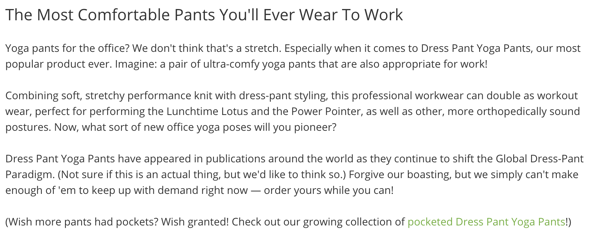
2. Fabletics
One of the main things that Fabletics does really well is social proof. Below their product descriptions, they include a large graphic that discusses reviews and customer happiness.
They even tell you how many people have reviewed the product and the percentage of people who were happy with it.
The reason this works really well is because it makes the visitor feel like everyone likes the product, so there's no reason not to purchase it.
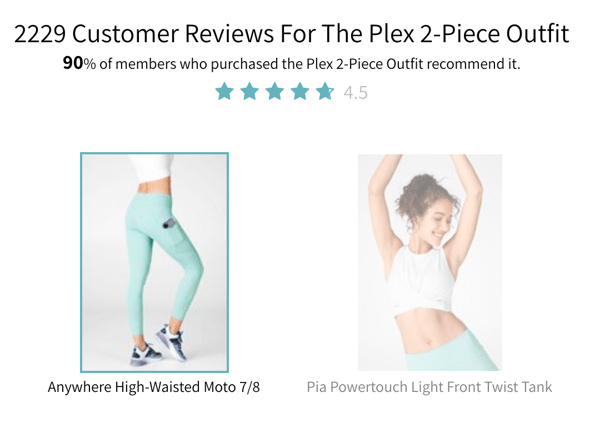
3. Wayfair
The Wayfair product description is probably the most extensive. Besides the description itself, the product page includes graphics at the top and expandable information at the bottom, including reviews and questions and answers.
Additionally, the product description itself is written really well. It tells a story so the reader can imagine themselves using the product. Plus, the description discusses benefits, while the bullet points review the features.
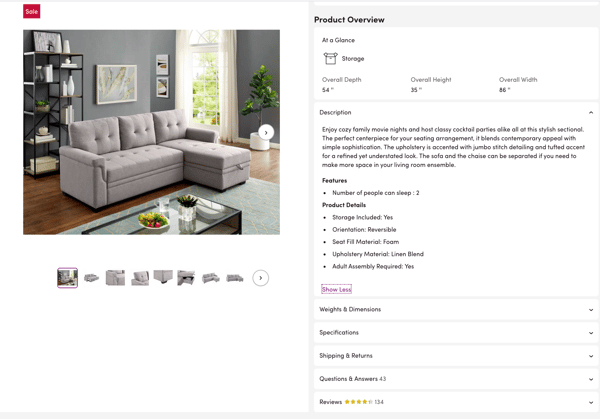
Product Description Template
Now that you know how to write a product description and you saw some examples, it's time to get started on your own.
While you're brainstorming the content you want to include, answer these questions:
- Who is the product for and what kind of language are they using?
- What are the main benefits of your product?
- How does someone use your product?
- What's the value of your product? Why is it better than competitors?
These answers should give you a good place to start.
Once you have all the information you need, consider using this formula:
- Begin by telling a story and setting the scene (about 1-2 sentences)
- List the benefits of using your product (can be a bulleted list of maybe 3-5 items)
- Finish by including social proof if you can (a quote or award)
All the while, make sure you're sprinkling in details and optimizing for keywords based on your research. Additionally, below your description, you might include reviews or graphics that list out some key features.
Product descriptions are an important element of your product pages. They help tell the story of your product so your visitors can imagine themselves using it.

The 5 Best Podcast Editing Software, According to HubSpot's Senior Podcast Producer
You've had the thought. You know — the one that kicks in on your way to the store, during the daily traffic jam, or underneath your subconscious before you fall asleep each night: I should make a podcast.
One of podcasting's most endearing qualities is its accessibility. Not only can anyone make a podcast, but everyone should make a podcast. Yeah, I said it. Hot take around some circles.
Hitting the record button and talking into a microphone isn't exactly going to land you on NPR. Your supportive aunt Janet might throw you a listen, but most audiences today expect a higher level of quality than an unedited, forty-five minute piece of audio. Even Janet deserves it. She's such a loyal listener.
Editing a podcast means everything from cutting tape, to mixing tracks, to compressing audio. And the software you'll do it all inside is a digital audio workstation (DAW).
Your choice in editing software should first take a close look at your budget and goals — not your dreams of becoming the next Ira Glass.
Every DAW is different, and the purpose each one serves varies, sometimes wildly. But there's a right DAW out there for everyone. So let's get you that meet-cute moment and take a look at the top podcast editing software.
Best Podcast Editing Software
1. Pro Tools
Pro Tools is the Tesla Coupe DeVille of podcast editing software. While it won't make you sound like a public radio program, it's more than likely the software they're all using to package up audio stories.
Pro Tools is the industry standard for a reason. It has every possible tool imaginable for recording, editing, and mastering your audio. But with all those bells (and while we're at it, all those whistles, too) comes a heavy price tag.
If you're just starting out, resist the urge to dive head first into the proverbial podcast waters by using Pro Tools — unless you're ready for a steep learning curve. But once you've mastered the craft, you can use any DAW out there.
2. Adobe Audition
Adobe Audition comes with everything you need. And if there's something missing? You can tack on all the add-ons to your heart's content.
But the real upside to Audition is the Adobe Suite — because, like Steve Jobs would say, it's all about the ecosystem.
If you're turning out podcasts, there's a good chance you're powering that personal unicycle and spinning your fair share of plates. Your role likely involves much more than just editing. Knowing that, Adobe can simplify your entire workflow.
Let's talk through this — you master your final episode, and have some standout clips you want to feature in social promotion. With Adobe, you can quickly grab those clips, send them into After Effects to design an audiogram for your social, and get ready to send it out into the world with Adobe Media Encoder.
Given the cost of Audition, it's likely the best option if you're already part of the larger Adobe Suite. If you're a hobbyist at heart (and financially), then Audition might be less of a priority.
3. Descript
The evolution of Descript is worth noting. What started off as transcription software, Descript has grown into a ‘no experience necessary' podcast editing software. And the entire experience is rooted in editing text — not audio.
You can record directly into Descript or add a recording in later. Descript will spin up a transcription, and you can edit the audio by editing the text. Don't like a certain sentence? Delete it from the transcription and the edit is made inside the audio track.
There's handfuls of other editing tools at your disposal. The unique editing workflow might rub more experienced producers the wrong way, but it's an easy way for beginners to start making a podcast.
Descript also recently announced the new AI-powered voice replication service Overdub. Fun fact: We use it at HubSpot and now have a robot version of Weird Work with host Sam Balter.
4. Audacity
Audacity is almost more of an ethos than editing software these days.
Yes, it has everything you need to start podcasting. Yes, that means tools that rival the ones you'd find in more expensive DAWs. Yes, it looks like it was designed during the waning days of 1998.
But the best part of Audacity: It's completely free (and it's open source).
5. GarageBand
The Apple music app mainstay Garage Band is mostly known for its digital swath of instruments and music making capabilities. I mean, ‘band' is in the name. But GarageBand is also an underserved podcast editing software.
The convenience of GarageBand is simple: if you own a Mac, then you own GarageBand. If you can use it to make and edit music, you can use it to make and edit podcasts.
You can cut tape quickly, move sections of audio around, and layer in sound all in that classic Apple user-friendly experience.
GarageBand is a great option for folks who already own Apple products, are new to editing, and want to learn the basics of what podcast editing software has to offer.
If you're interested in starting a podcast for your own business, take a look at some of the editing tools mentioned above — and then explore our additional podcast resources to learn how to create a compelling podcast, convert existing content into a podcast, or design a podcast for SEO benefits:
- The Anatomy of a Perfect Podcast Episode, According to HubSpot's Podcast Expert
- How to Reepurpose Content Into a Podcast, According to HubSpot's Podcast Expert
- Designing a Podcast for Audio SEO, According to HubSpot's Podcast Expert
Ultimately, podcasting isn't going anywhere — and it continues to rise in popularity. In fact, nowadays, almost one quarter of all Americans listen to one podcast each week. Podcasts should be part of every brand's content strategy. I might be biased, but podcasts are the best way to increase brand awareness, engagement, and authority in your industry.

How HubSpot Built a World-Class Conversational Marketing Program
Over the last few years, HubSpot's audience has gotten chatty. Chatbots and live chat became some of the most popular ways to reach HubSpot and the humans here. For years, prospects have wanted to ask questions and get direction while navigating the website.
In the past, we met this need with live chat that handed off to "coaches". These coaches answered questions about pricing and features; they also helped free users better use their tools. Demand on this channel grew faster than our ability to hire coaches, so we scaled our live chat programs with chatbots.
Those chatbots triaged, qualified, and routed prospects to the right team or content resource. Over time, we found that folks who engaged with chat used the product more often than those who didn't. Here’s what we did about it.
Reducing Chatbot Friction
Above all else, our goal was to create a remarkable customer experience with conversational marketing. Enabling prospects to cut through the noise and ask for help in their own words removed friction in the flywheel.
We believed — and still do — that it’s always easier for users to see value in the free tools they're using. This came from our deep belief that "how you sell is why you win". Growing businesses often have to juggle dozens of tools, but don’t often have the opportunity to ask questions about how to use them together.
Ambitious businesses deserve great software and experiences to power it.
Aligning Marketing, Sales, and Chatbot Technology
The hardest part of conversational marketing isn’t the technology — it's the empathy and alignment that takes lots of time and energy to get right. To solve this, our marketing and sales teams met to understand the start-to-finish chat experience.
It was interesting to see how two departments viewed the same situation through varying lenses. Marketing gained empathy for how Sales handled conversations, including repetitive processes.
Sales came to appreciate what chatbots could do to make their lives easier. From there, both departments came up with shared metrics that aligned us around a holistic customer experience.
Here are some that may apply to your business:
- Deflection rate: the % of engagements with chatbots that don't reach a human.
- Handled chats: the # of conversations that coaches have with prospects.
- Pass rate: the % of handled chats that are a good fit for sales.
- Customer Satisfaction (CSAT): the % of bot and human engagements that prospects marked as positive.
These shared metrics gave Marketing a better sense of which types of chats — and how many — should or shouldn't reach the coaches. They could build tasteful conversational experiences that sifted incoming messages.
Standard questions could be self-served, and nuanced ones could escalate to coaches. This approach created a more delightful interaction for the humans on either side of the screen. Users didn't have to wait for a human to answer documented questions, like "How do I add a user to my portal?", and coaches could spend more of their day answering questions like "How do e-commerce businesses use email?"
This was a better use of everyone's time. As the mix of questions shifted, so did the knowledge needed to help users. Sales made material investments to develop the coaches and get them more comfortable with the nuances of the product.
Despite the performance gains in this time, there was more work to do. Conversational marketing is not a set-and-forget channel — it's a living, breathing engine that needs attention and love.
One thing we noticed was that response times had a direct correlation to the quality of the conversation. As such, response time became a "North Star" metric for the Sales team. The sales team began to goal and coach the team towards getting back to prospects as fast as possible.
This process gave us most of the pieces for a great customer experience, but we had to close the feedback loop. Conversational marketing is an iterative strategy, one that works best when we listen and act on what users want.
What's great about live chat and chatbots is that people will tell you what they want in their own words, so you don’t have to read between the lines about their goals. To do that, we connected Feedback Surveys and Conversations, so users could provide feedback after their chat ended. Quantifying how users felt helped us a smoother, data-infused roadmap.
Analyzing the Results
At the start of 2019, our hearts were in the right place with conversational marketing, but we weren't meeting the needs of our audience. By aligning Marketing, Sales, and the technology to get there, we built a conversational marketing engine we could be proud of.
We more than doubled the mix of chats that came from high-value free users inside the HubSpot portal. Coaches were able to help users get more value out of their tools, which had a notable impact on the value those users saw from the product. When we closed out 2019, more than 30% of HubSpot's total revenue came from our conversational marketing efforts.
But none of that mattered if we weren't solving for the customer. These conversational marketing programs had to feel good for users. There's an expected sense of immediacy from chat, which is why we chose to prioritize response time.
Today, 80% of conversations get a response in under 20 seconds — a 10x boost from the start of 2019 (when only 8% of conversations saw this response time). The alignment between chatbots and coaches paid off, too, as customer satisfaction scores went up by more than 50%. Listening to your audience and acting on their feedback goes a long way.
Conversational Marketing in 2020 and Beyond
2019 was a huge year for building the conversational marketing engine at HubSpot. But there's more work to do in 2020. The teams will continue to invest in a consumer-grade and world-class experience. The next frontier we'll face is meeting users where they are.
Messaging platforms like SMS and WhatsApp continue to be where people spend more time. We're working towards our audience reaching HubSpot wherever it feels natural. None of this would be possible without the alignment and investments made in 2019.
It goes to show that a remarkable customer experience is everyone's job.

How to Reduce Page Weight on Your Website [Quick Guide]
When it comes to your website pages, size matters. The smaller the file size of a page, the faster it will load for anyone who requests it.
And people do notice how long a page takes to load. In fact, according to data from Pingdom, 24% of users will abandon a site that takes four seconds to load, and 38% of users will leave the page if it takes five seconds.
Not to mention, Google has admitted to using site speed in web search ranking, as faster sites tend to create happier users.
Additionally, nowadays, plenty of searchers use their mobile phones to find and explore websites —where spotty internet connections and slow data speeds make it even harder to load large page sizes.
Ultimately, in order to maintain a healthy page rank, your business needs to be focused on delivering a fast, optimized website experience across all devices. To ensure your website doesn't take a hit in traffic,this post will explaineverything you need to know about page size and how to reduce it.
What's Page Size?
"Page size" — also called page weight — refers to the overall size of a particular web page.
A page size includes all of the files that are used to create the web page, including the HTML document, any included images, scripts, and other media.
What's a good size for a webpage?
To help you benchmark the weight of your page, we took a look at the average size of a webpage (on both desktop and mobile) between February 1 2020, and March 1, 2020:
In 2020, the average desktop webpage weighs 2080 KB, while the average mobile webpage weighs 1885 KB — this is a stark difference from 2017, when an average desktop webpage weighed 1532 KB and the average mobile webpage weighed 1354 KB.
Of course, it's important to note, the data above displaysaveragesize of a typical webpage — which means plenty of websites likely fall far below this size, while other heavier ones might skew the data in the other direction.
Ultimately, it depends on the site. While some sites might incorporate custom fonts, full-screen video, and other design elements that "weigh" the page down, other sites likely take a minimalist approach and stick to simple text and a white background.
Keep in mind that the weight of your pages will vary depending on your company or industry. If you have an ecommerce website with a wide variety of photos, it's likely that you can anticipate a larger page weight.
But, in general, you should aim to be at or below the average.
Of course, it's equally important to keep in-mind — page weight isn't always the most important metric to consider.
Take Amazon as an example — using Google's PageSpeed Insights, I searched Amazon.com and saw they score a measly 51% out of 100% for page performance:
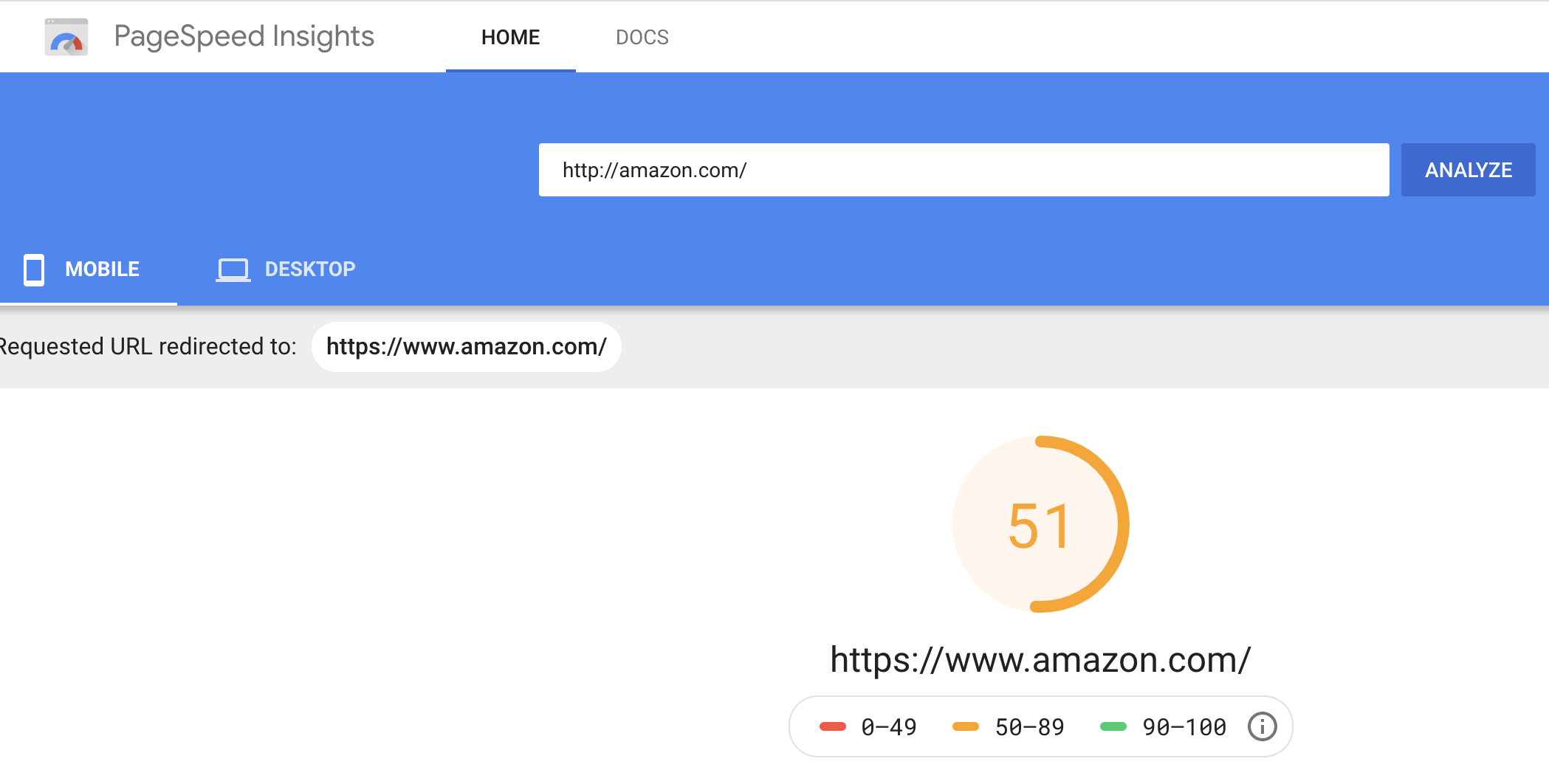 Of course, for Amazon, this likely doesn't matter — they need heavier pages, of course, to display images of all the thousands of products and services they sell, and users don't mind the load-time because they know what to expect.
Of course, for Amazon, this likely doesn't matter — they need heavier pages, of course, to display images of all the thousands of products and services they sell, and users don't mind the load-time because they know what to expect.
However, if you're unsure whether your page weight could disproportionally lower your overall page quality, try inputting your own website into Google's PageSpeed Insights to gauge overall performance.
If you're unhappy with your current page speed or think your page weight should be lower, let's explore how you can decrease that weight right now.
5 Tips for Reducing Page Size
1. Resize and Compress Your Images
When it comes to page weight, images are one of the largest contributors. If you're looking to downsize, you'll want to start by resizing any unnecessarily large images.
When uploading photos, keep in mind that the image dimensions should never be greater than the size of the container. If the container has a maximum width of 500 pixels, there's usually no reasonto upload a 1,000 pixel-width image.
But let's say you'd like to offer a high resolution image people could share and download — what should you do? We recommend uploading a picture that's exactly the width of the container it's in and hyperlinking it to the high-resolution version to avoid weighing down your page.
Aside from image dimensions, you can further shrink the size of an image by compressing it. Compressing an image helpsreduce its file size, which ultimately helps to reduce the time it takes for a page to load.
If you're looking for a compression tool, these are some of our favorites:
If you're a HubSpot user, you're in luck: The HubSpot COS features automatic image resizing and image compression.
"If a user uploads an image that has dimensions of 5,000 x 5,000 but is only displaying it on the website as 500 x 500, then using auto-image resizing will help decrease browser load-time. Image compression, on the other hand, decreases the file size while retaining the quality of the image that was uploaded," explains HubSpot's Maggie Himba.
Of course, the easiest way to slim down the weight of your page is to eliminate as many unnecessary images as you can. But for the ones that need to stay, the tips mentioned above should do the trick.
2. Use CSS Sprites
So now we know that having a ton of images — especially large ones — on any given page is going to increase the page weight and slow down the load time, right?
This is because every image generates a server request, which slows down the entire process.
Enter CSS sprites.
A CSS sprite refers to a collection of images that are combined to create one image file,according to W3School. Then, you use CSS to only display the part of the combined image that you'd like to appear.By doing this, you're reducing the number of server requests necessary for the page to load.
To clarify, below is a more visual explanation. Example A includes separate image files for each of the browser icons, totaling 70.7 KB. Example B uses CSS sprites — one image that uses CSS to display portions of that image — to show the same exact information. The total size of those images is less than half of Example A.
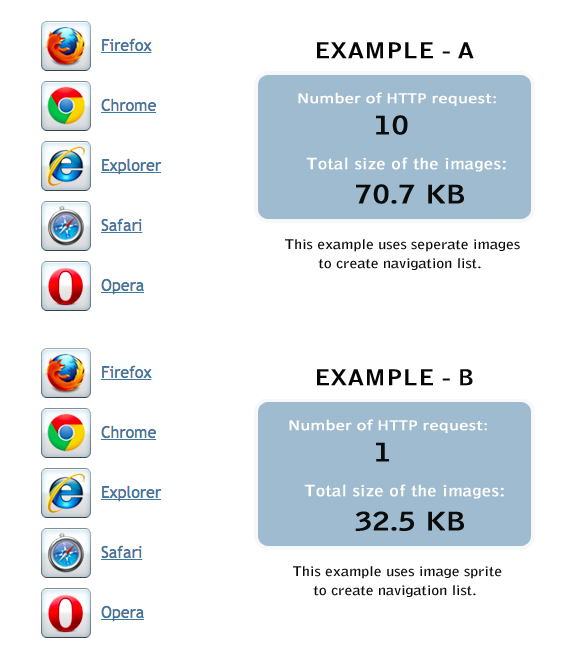
Source: Tutorial Republic
3. Remove Unnecessary Custom Fonts
Custom fonts are fun.
They add personality to your pages and help to differentiate your business from everyone else. However, the trouble with custom fonts is that that they can carry some weight.
Fortunately, there is a solution if you feel custom fonts are necessary for the design of your website: creating a WOFF2 file.
As Joshua Stopper, Lead Developer at Wholegrain Digital, writes: "Arguably the easiest change that can be made, that has no downsides, is converting the [custom] font to the most modern and efficient format available in browsers, WOFF2 ... in our case, we achieved a 60% reduction simply through loading a WOFF2 file over a TTF."
However, if you're looking for any easy way to trim some weight off your page, you may want to reevaluate the number of custom fonts you're using. While a couple won't hurt, using them in excess could still hurt your page speed.
4. Minimize Resources
Could one of your resources be reduced through minification?
"Minification refers to the process of removing unnecessary or redundant data without affecting how the resource is processed by the browser — e.g. code comments and formatting, removing unused code, using shorter variable and function names, and so on," Google Developers explain.
According to Google, here's how you should approach minifying your resources:
HTML
Generate an optimized version of your HTML code using thePageSpeed Insightstool. Use this analysis to run your HTML page and browse the 'Minify HTML' rule. Finally, click 'See optimized content' to access the minified HTML code.
CSS
Check out the following tools:
JavaScript
Check out the following tools:
5. Use a Content Delivery Network (CDN)
A content delivery network refers to "an interconnected system of cache servers that use geographical proximity as a criteria for delivering web content," according to TechTarget.
What does that mean? And why should you care?
Let's say that all of your website's elements are stored in Boston, Massachusetts. That's great news for the Bostonian's — or anyone in the United States — who are trying to access your site pages. But what about that loyal visitor all the way over in London? It's likely that it's going to take noticeably longer for them to load your pages just because of where your server is located.
A CDN aims to resolve this by storing your website's elements in multiple locations around the world to ensure that everyone has a fair shot at a speedy load time.
Note: While this step won't necessarily reduce the weight of your page, it will help to improve its speed — which is what we're really after anyways, right?
Ready to weigh in?
Before you can apply these tips, it's best to start by getting a feel for what you're working with. To testyour website's speed and size, check out Web Page Analyzer from WebsiteOptimization.com.
And if you want a more detailed report of your website's overall performance, check out HubSpot's newly redesigned Website Grader. You'll receivea free personalized report that grades your site onkey metrics including performance, mobile readiness, SEO, and security.

A Step-by-Step Guide to Advertising on Instagram
With 500 million active monthly users, Instagram offers a unique opportunity for marketers to reach their target audiences through ad campaigns.
The other perk of advertising on Instagram? The ads can look almost no different than regular posts, making them much less invasive than other ad types.
But setting up ads on any platform requires a lot of thought: What should your target audience look like? What should your copy say? What image should you use? There are a number of ads tools available that can help you create your ads and targeted audiences, but there's still the more technical aspects to consider like what size your image needs to be or how long your ad should run for.
To simplify the process, we’ve put together a checklist to help you set up a campaign, one step at a time.
How to Create Instagram Ads: A Step-by-Step Guide to Advertising on Instagram
If you’ve ever set up a Facebook ad, you’re about 75% of the way there. After Facebook acquired Instagram back in 2012, the platforms conveniently merged, making setting up Instagram and Facebook ads merely the difference of a couple clicks. So even though your intent is to run ads on Instagram, all of the ad setup, budgeting, scheduling, and creation is done through Facebook's platform.
To start, log into your company’s Facebook portal and select the account you wish to use. (Note: To run ads on Instagram you'll need to use a Facebook Page. Pages are specifically for businesses, brands, and organizations, while regular Facebook accounts are for personal use.)
1. Select an editor and create your campaign.
You can create Instagram ads using a few different tools:
When choosing which tool to use, you’ll want to consider both your company size and the number of ads you plan to run at once. If you're managing a large number of campaigns, or you're looking for really precise control over your campaigns, you might want to lean towards the Power Editor. However, the Ad Manager suits most marketers' needs, so that's what we'll use for the sake of this article. (For more on the Facebook Ads API option, check out this page.)
Once you've selected an editor, you’ll see an option to either view all campaigns, or create a new one. To get started with an Instagram ad, you'll want to create a new campaign.
2. Determine an objective.
You'll notice that there are several different campaign objective options to choose from here. However, in order for your ad to be eligible to appear on Instagram, you'll have to choose from a slightly shorter list:
- Boost your posts
- Send people to your website
- Increase conversions on your website
- Get installs of your app
- Increase engagement in your app
- Get video views
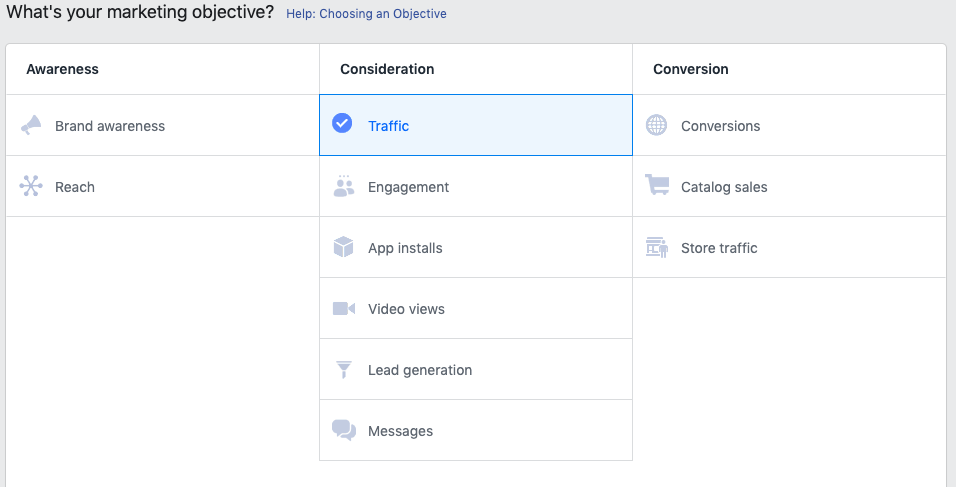 For this article, we're going to select: "Traffic."
For this article, we're going to select: "Traffic."
When you select this option, you’ll be prompted to name your campaign. This may seem like a simple task (and it is) but it's a good idea to have some sort of naming convention or set process within your company. This will make it easier for you to keep campaigns straight as you continue to create them.
Here at HubSpot, we like to name them in this format:
Company Department | Content/Offer/Asset Being Advertised | Date | Name of Creator
3. Choose your audience.
If you’re just starting out with Instagram advertising, odds are you won't know exactly which audience you want to go after. This will come with time, and you may just have to play around with it at first. (If you want tips to help you choose the right audience, check out this page.)
During this step, you'll find that the platform’s built-in targeting can be as simple or as extensive as you need it to be, with options such as:
- Location
- Age
- Gender
- Language
- Relationship
- Education
- Work
- Financial Status
- Home
- Ethnic Affinity
- Generation
- Parents
- Politics (U.S. only)
- Life Events
- Interests
- Behaviors
- Connections
You can create what’s called a custom audience to reach people who’ve already interacted with your business, or a lookalike audience to reach new people on Facebook who are similar to your most valuable audiences.
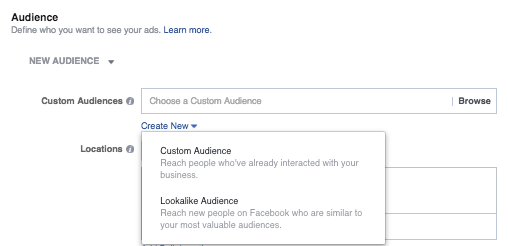
The ads platform also allows you to save the audience you create to be used again at a later time, which can be good if you’re experimenting and want to remember the exact audience you used for certain campaigns.
In terms of the objective we selected — "send people to your website" — we'll want to target a more specific group of people: the type of people who are actually going to be interested in the content we present.
To do this, you'd jump down to the "Detailed Targeting" section, and search for different demographics, interests, or behaviors that apply to your target audience. Here’s an example of a (very small) audience, just to show you the different ways you can target certain people:
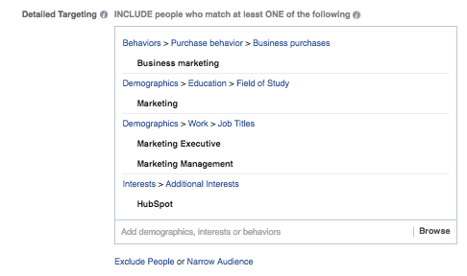
To give you a sense of the audience you’ve chosen, Facebook provides an "audience definition gauge." This gives you immediate feedback on how narrow or broad your audience is, as well as the estimated reach number of your ad. Since we didn’t add very much criteria to our targeting, you'll notice that the audience appears "fairly broad."

4. Set your placement.
This step is the biggest differentiator between setting up Facebook ads vs. Instagram ads. To move forward with the Instagram ad, you’ll want to uncheck all the boxes except for "Instagram."
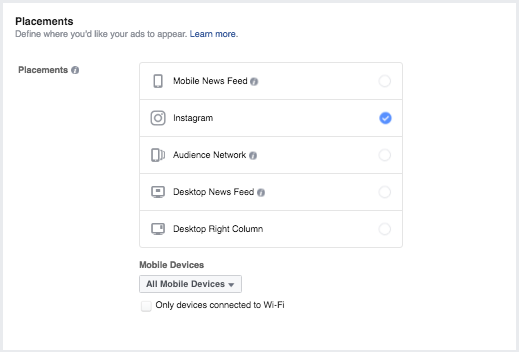
5. Make your budget and schedule.
You have the option to select either a daily budget or a lifetime budget for your campaign. The difference is this:
- Daily budget sets your ad up to run continuously throughout the day, meaning that the algorithm will automatically pace your spending per day. Keep in mind that there is a minimum daily budget depending on different factors in your campaign, usually around $1.00.
- Lifetime budget sets your ad up to run for a specified length of time, meaning the ads algorithm paces your spending over that entire time period.
The other aspect to setting your budget is setting your schedule. You’ll need to choose exactly when you want your campaign to start and finish running, down to the minute. There are also options to set parameters so that your ad runs only during certain hours of the day or during specific days of the week. You can find these options in the "Ad Scheduling" section.

Then, you can set your ad up for delivery. Here, you have three options that will influence who sees your ads.
- Link Clicks: Your ads will be delivered accordingly to get the most clicks to your website at the lowest cost. This is all based on the platform's algorithm.
- Impressions: Your ads will be delivered to people as many times as possible. Ever see the same ad on your newsfeed all day long? That company is most likely using this option.
- Daily Unique Reach: Your ad will be delivered to people up to once a day. People may see your ad multiple times, but at least not multiple times a day.
Then, after you choose your delivery method, you will have to figure out your bid amount.
This determines how effectively your ad is delivered. When you look "behind the scenes," you’re competing with other advertisers trying to reach a similar audience in a constant auction.
You can choose either Manual or Automatic. Automatic leaves it up to Facebook’s algorithm to deliver your ad — ideally getting you the most clicks for the lowest cost. Manual allows you to set a price for link clicks. If a link click is worth a lot to you, try setting a higher than suggested bid, and your ad will be displayed over a competitor with a lower bid.
You can choose to pay based on impressions or link clicks. This is up to you.
After that, you can schedule your ads. Here are the options you have for delivery:
- Standard: shows your ads throughout the day.
- Accelerated: helps you reach an audience quickly for time-sensitive ads.
(Note: the accelerated delivery option requires manual bid pricing.)
Finally, you'll have to name your ad set so you can identify it in Ads Manager later.
6. Curate your ad creative.
This is where your creativity comes in. Here you'll decide what you want your ad to look like, which will depend on your original objective, of course.
(Psst — Want to get a stunning Story auto-magically created for your brand? Check out StoriesAds.com, a free Instagram Story generator from HubSpot and Shakr. Click here to get started.)
On Instagram, you have a couple different options for your ad:
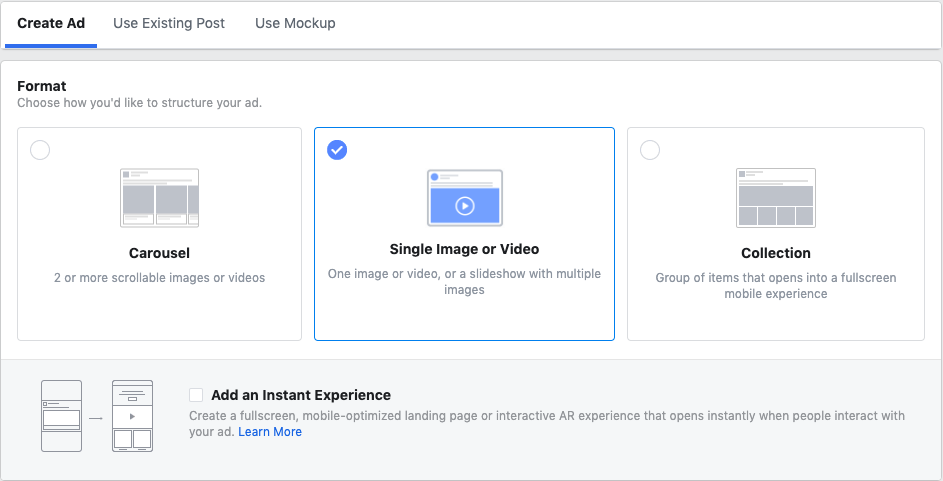
Single image or video, carousel, or collection.

A video posted by dunkindonuts (@dunkindonuts) on May 18, 2016 at 7:25am PDT
Up to five images or videos for the viewer to scroll through, at no extra cost.

We actually ran some tests to see which type of ad performed the best for different purposes. Check out the results in here.
Once you pick your ad type, click on it and you’ll be prompted to browse and upload your imagery, whether that be images or a video.
For any ad type, the Facebook ads platform recommends you don’t include more than 20% of text. Previously, an ad with over 20% of text wouldn’t even be approved to run, but it has recently changed to more of a suggestion than anything. Learn more about the rules and guidelines here.
Some requirements for Instagram ad imagery:
File Type
- .jpeg
- .png
Text/Caption
- Recommended: 125 characters
- Maximum: 2,200 characters
Square Image or Video ad
- Recommended Image Size: 1080 x 1080 pixels
- Minimum Resolution Accepted: 600 x 600 pixels
- Image Aspect Ratio: 1:1
Landscape Image or Video ad
- Recommended Image Size: 1200 x 628 pixels
- Minimum Resolution Accepted: 600 x 600 pixels
- Image Aspect Ratio: 1:1
7. Build your page & links.
The next step is to build your page and set up links. Select the Facebook Page of the account you want your ads to come from, even if you’re not planning on running them on Facebook. (If you've made it this far in the Ads Manager, you are already logged into a Facebook account.)
However, since our intent is to post ads on Instagram, you’ll need to connect your Instagram account to your Facebook ad account. To do so, click "Add Account" (you'll need your Instagram username and password to do so).
If your business doesn’t have an Instagram account, you can still run ads on Instagram — they’ll just come from your business' Facebook Page instead. In other words, your Facebook Page name and profile picture will be used to represent your business within your ad as it runs on Instagram.
Next is a very important step: putting in the website URL to which you’re trying to drive more traffic. If you're using marketing automation software, be sure to create a unique tracking URL with UTM parameters for this to ensure that you'll be able to keep track of traffic and conversions from this ad.
(HubSpot customers: Learn more about creating a tracking URL here.)

Next, you'll add a headline. This is not usually displayed to viewers of your ad on Instagram, but it’s always a good idea to complete it just in case. Enter a brief headline describing where people will visit.
After making a headline, you'll add a caption.
You have up to 2,200 characters — but you don't have to use all of them. Facebook recommends you keep your text under 125 characters, which is the amount that’s displayed without needing to click "more."
Select a Call-to-Action.
There are several different options for your CTA button, depending on what the page you’re taking visitors to looks like. You can choose to have no button, or select any of the following:
- Learn More
- Apply Now
- Book Now
- Contact Us
- Download
- Hope Now
- Sign Up
- Watch More
For our sake, we’ll stick with "Learn More," as we’re just driving people to our website.
Once your image is uploaded and your text is set, check out the preview of your ad to make sure everything looks right.
At this point, you'll have the option to edit the "Advanced Options," but only if you wish. Advanced Options include adding tags, changing your display link, entering URL parameters, setting up sponsors, and opting in or out of pixel tracking.
Then, you're ready to place the ad! Click the green button to confirm, and your ad will be presented to the world.
8. Report on the performance.
Once your ads are up and running on Instagram, it’s important to keep an eye on how they’re doing. You can go back in and tweak most aspects of the ad, so if you catch a mistake you made or your image isn’t doing as well as you’d like it to, you can go in and alter these things.
You can look at results of your ads in two places:
- The Facebook Ads Manager
- Your marketing software
In the Ads Manager:
There’s a sophisticated and extensive dashboard that provides users with an overview of all their campaigns. Without customizing any settings, you’ll find data on reach, cost per result, and amount spent.
In the upper right-hand corner, you’ll see a button that says "Columns: Performance." If you click the drop down menu, there’s an option to customize columns, which allows you to choose the specific data you want to see. There’s data ranging from CPC or CTR, to things much more specific like "Adds to Cart" for ecommerce stores.
Here are the categories that the available metrics fall into:
- Performance (reach, results, frequency, etc.)
- Engagement (post likes, post comments, post shares, etc.)
- Videos (video views, average percent of video viewed, etc.)
- Website (checkouts, payment details, adds to cart, etc.)
- Apps (installs, engagement, cost per app engagement, etc.)
- Events (event responses, cost per event response, etc.)
- Clicks (unique clicks, social clicks, CTR, CPC)
- Settings (start date, end date, ad set name, delivery, bit, ad ID, and objective)

With your marketing software:
With so many metrics to track, it can be easy to lose sight of the big picture. To truly track your success, take advantage of your marketing software and the UTM codes you used in your ads to measure your ads’ full-funnel effectiveness.
Looking at the specific tracking codes through your marketing software will help you keep track of how many leads (or better yet, customers) you actually generated through your Instagram advertising campaign. This ROI information can then be used to inform other campaigns down the line.
If you’re a HubSpot customer, you can create unique tracking codes for your Instagram campaign by following the instructions here. All you’ll need to do is plug in the URL, attach a campaign, and choose the source you want the URL to be attributed to in your Sources Report.
Once your ad launches and you start getting traffic and conversions to your website, you’ll be able to easily track how many visits, contacts, and customers you’re generating.
Have you seen success with Instagram ads? Let us know in the comments section below.

